Embracing the serene fusion of Japanese minimalism and Scandinavian coziness, Japandi living rooms create spaces that breathe tranquility into modern homes. This design philosophy merges the clean functionality of Nordic design with the natural elegance of Japanese aesthetics, resulting in living spaces that feel both calming and purposeful. What makes a living room authentically Japandi? The answer lies in carefully balancing neutral color palettes, natural materials, and uncluttered spaces that promote mindful living. These living rooms celebrate imperfection through wabi-sabi principles while embracing the warm comfort of hygge. Every element serves a purpose, from low-profile furniture that grounds the space to natural lighting that enhances the connection with nature. The beauty of Japandi design lies in its ability to create sophisticated yet welcoming environments where less truly becomes more, encouraging relaxation and peaceful contemplation in our busy lives.
1. Natural Wood Statement Wall
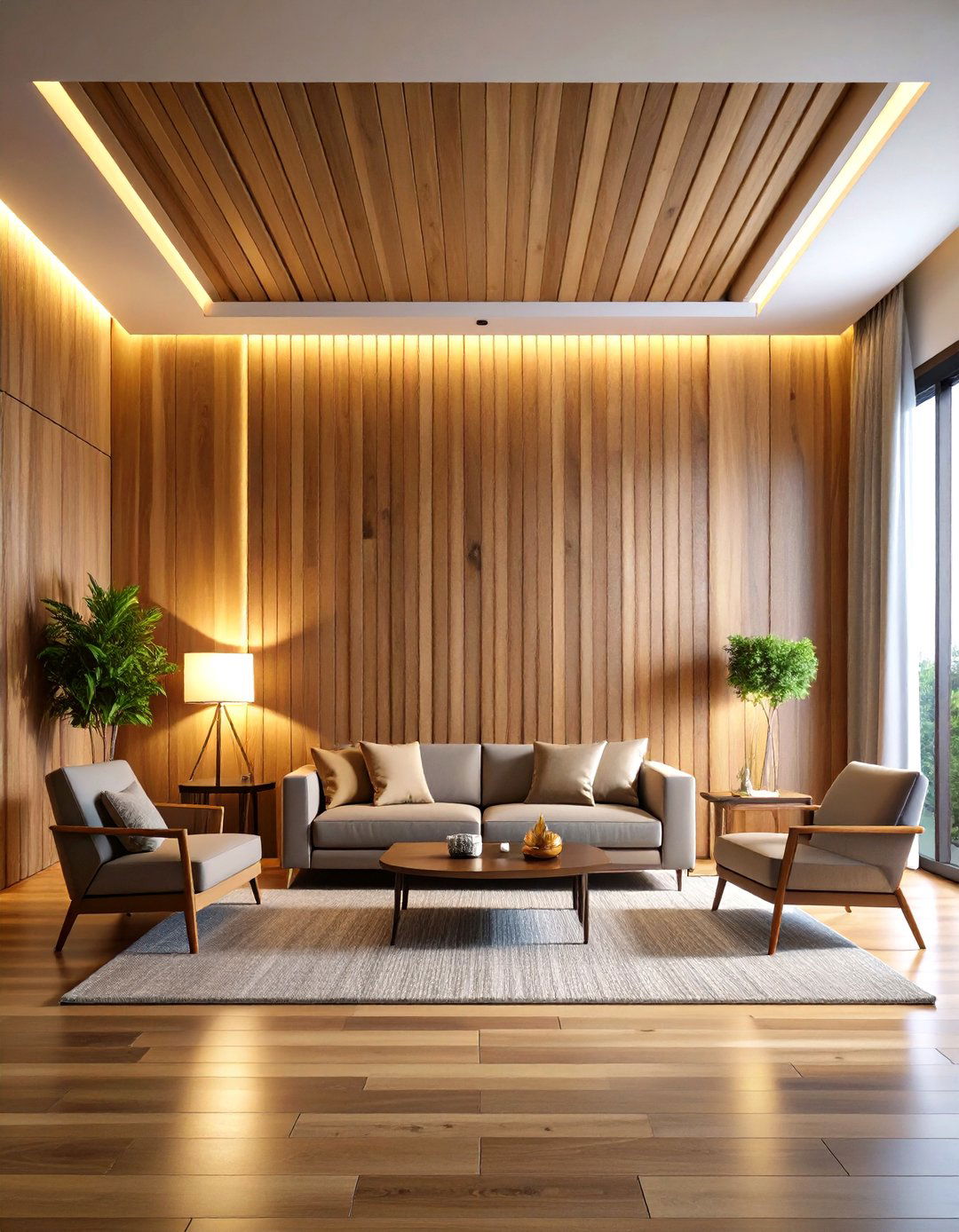
Transform your living room with a stunning wood slat feature wall that embodies Japandi principles. Choose light oak or ash planks arranged vertically to create visual height and warmth. The natural grain patterns add organic texture while maintaining clean geometric lines. This backdrop perfectly frames your seating area without overwhelming the space. What happens when you combine functionality with beauty in one statement piece? Consider integrating hidden LED strips between slats for ambient evening lighting. The wood's natural variations celebrate wabi-sabi imperfection while providing a sophisticated focal point. Pair this feature with neutral furniture to let the wood's natural beauty take center stage in your peaceful sanctuary.
2. Low-Profile Seating Arrangement
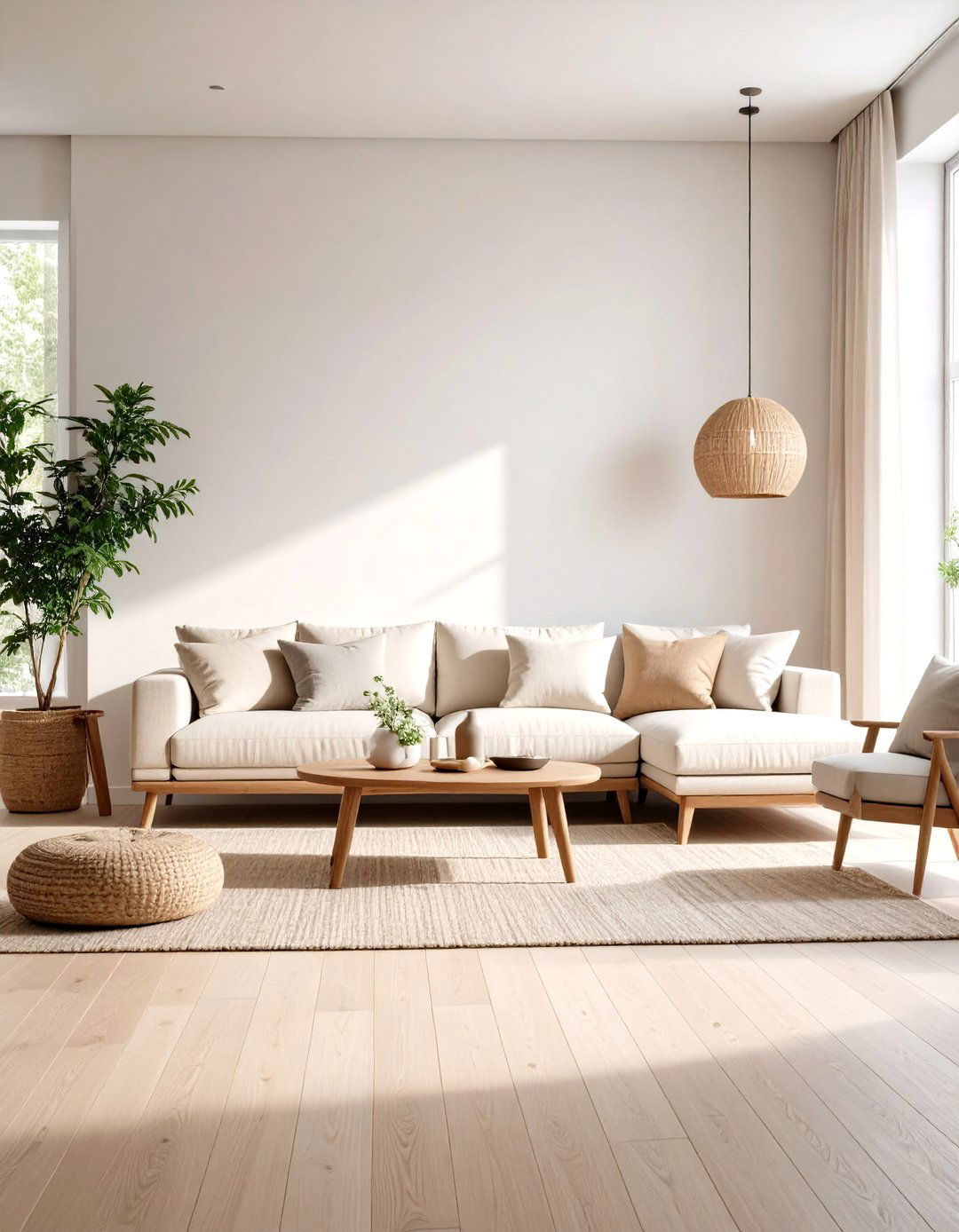
Create an intimate living space with floor-level seating that reflects traditional Japanese design sensibilities. Select a low-profile sectional sofa in cream linen paired with floor cushions in natural hemp fabric. This arrangement encourages relaxation while maintaining visual openness throughout the room. Can furniture actually make your space feel larger while providing ultimate comfort? Add a traditional Japanese zabuton cushion for authentic cultural elements. The low furniture height emphasizes horizontal lines and creates better flow between spaces. Complement this setup with a solid wood coffee table that sits close to the ground. This thoughtful arrangement promotes mindful sitting and conversation while honoring both Scandinavian functionality and Japanese simplicity in one cohesive design statement.
3. Neutral Color Foundation
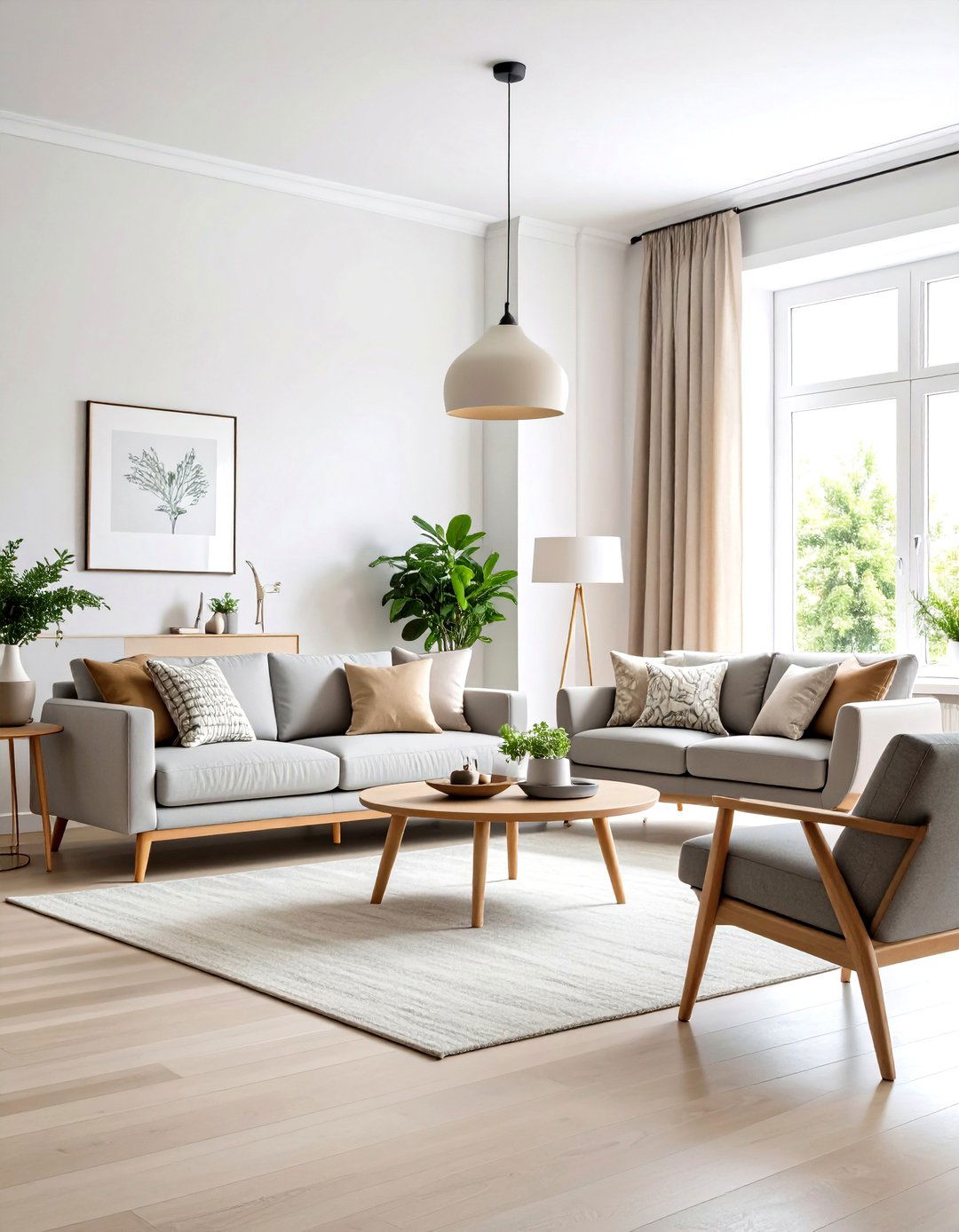
Establish perfect harmony with a carefully curated neutral palette that forms your living room's foundation. Begin with warm white walls in Swiss Coffee or Moonlight to prevent sterile feelings while maintaining brightness. Layer soft gray furniture pieces with beige and taupe accents through textiles and decorative elements. How do neutral colors create such profound emotional impact in living spaces? Introduce subtle depth with charcoal picture frames and black ceramic vases for sophisticated contrast. These muted tones reflect natural light beautifully while creating a calming backdrop for daily activities. The neutral foundation allows natural materials like wood and stone to shine as the room's true stars. This timeless approach ensures your Japandi living room remains stylish and serene for years to come.
4. Minimalist Lighting Design
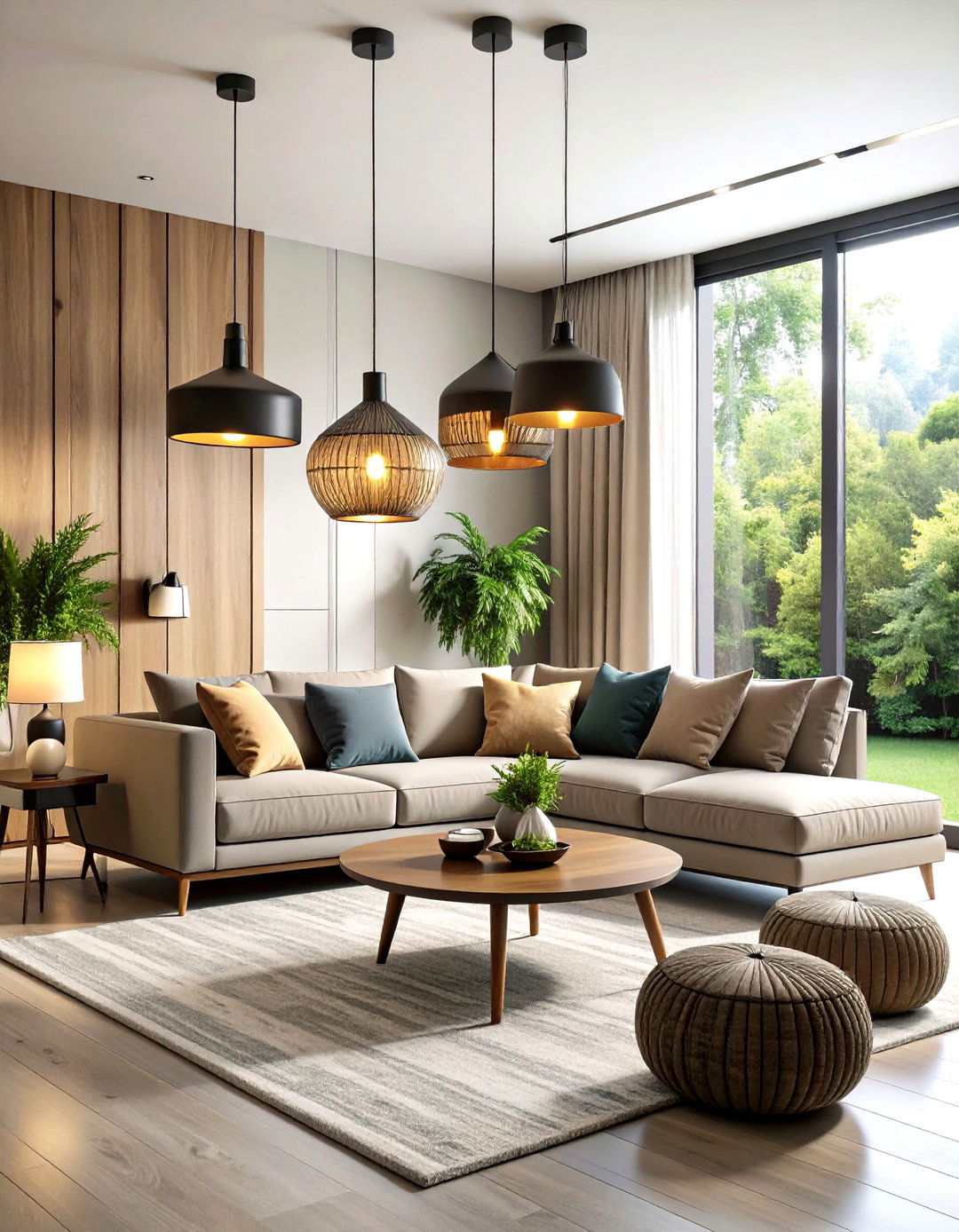
Illuminate your space with thoughtfully selected lighting that enhances the Japandi atmosphere without overwhelming it. Choose pendant lights with clean geometric shapes in matte black or natural wood finishes. Are you ready to discover how lighting can completely transform your room's mood? Install dimmer switches to control ambiance throughout different times of day. Complement overhead lighting with sleek floor lamps featuring rice paper or linen shades that diffuse light softly. Position table lamps strategically to create warm pools of light for reading and relaxation. Avoid ornate chandeliers in favor of simple, functional fixtures that blend seamlessly with your minimalist aesthetic. This layered lighting approach creates depth while maintaining the clean, uncluttered feeling essential to authentic Japandi design.
5. Natural Fiber Textures
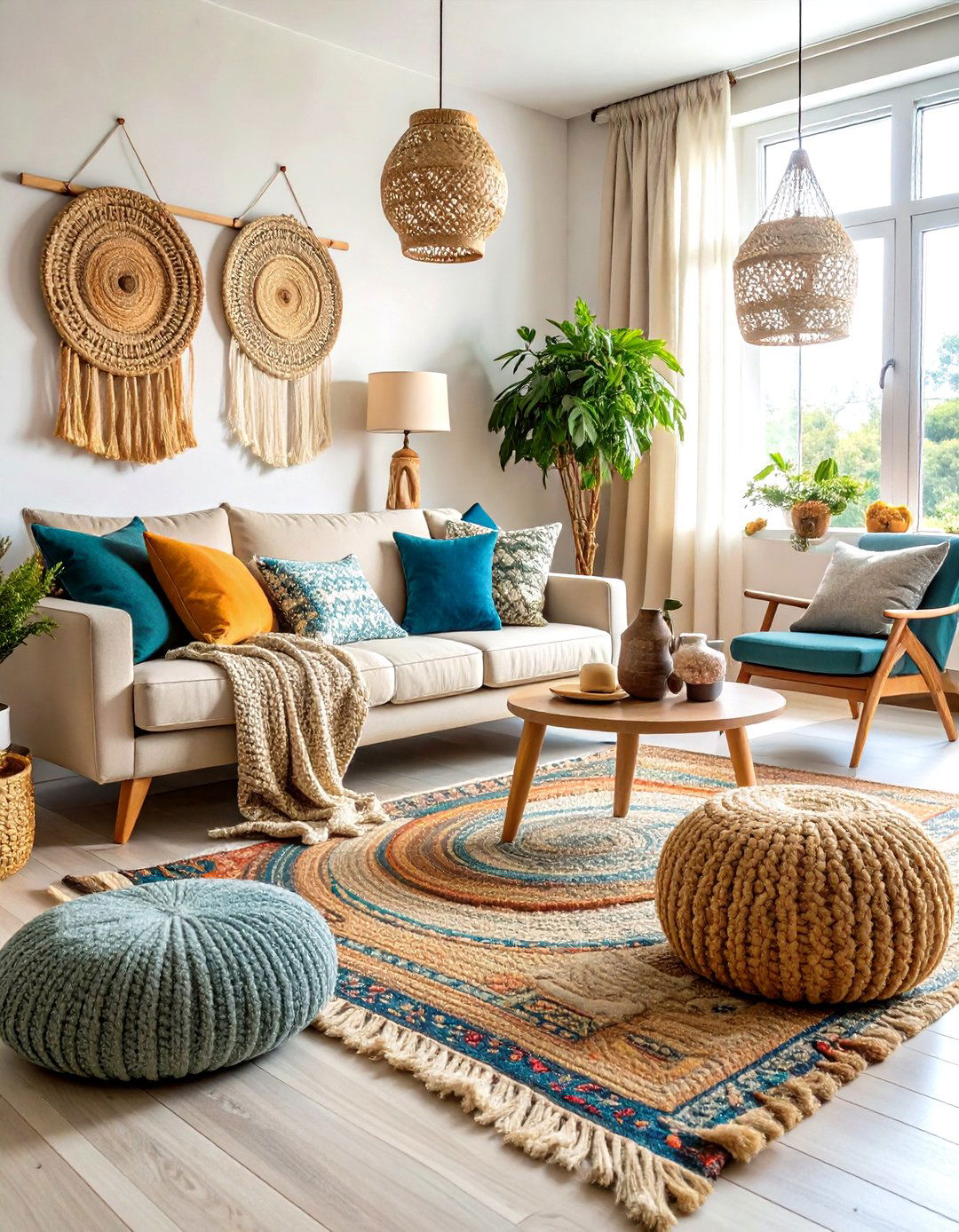
Layer your living room with organic textures that add warmth and visual interest without creating clutter. Incorporate a jute area rug with subtle geometric patterns beneath your seating arrangement. What magical transformation occurs when natural fibers meet minimalist design? Add linen throw pillows in sage green and warm taupe to your sofa for comfortable accents. Introduce a chunky wool throw in cream for cozy evenings and textural contrast. Consider woven wall hangings in neutral tones to add vertical interest and handmade charm. These natural materials age beautifully and develop character over time, embodying the wabi-sabi appreciation for imperfection. Hemp curtains can filter natural light while maintaining privacy and adding another layer of organic texture to complete your serene sanctuary.
6. Scandinavian-Japanese Fusion Furniture
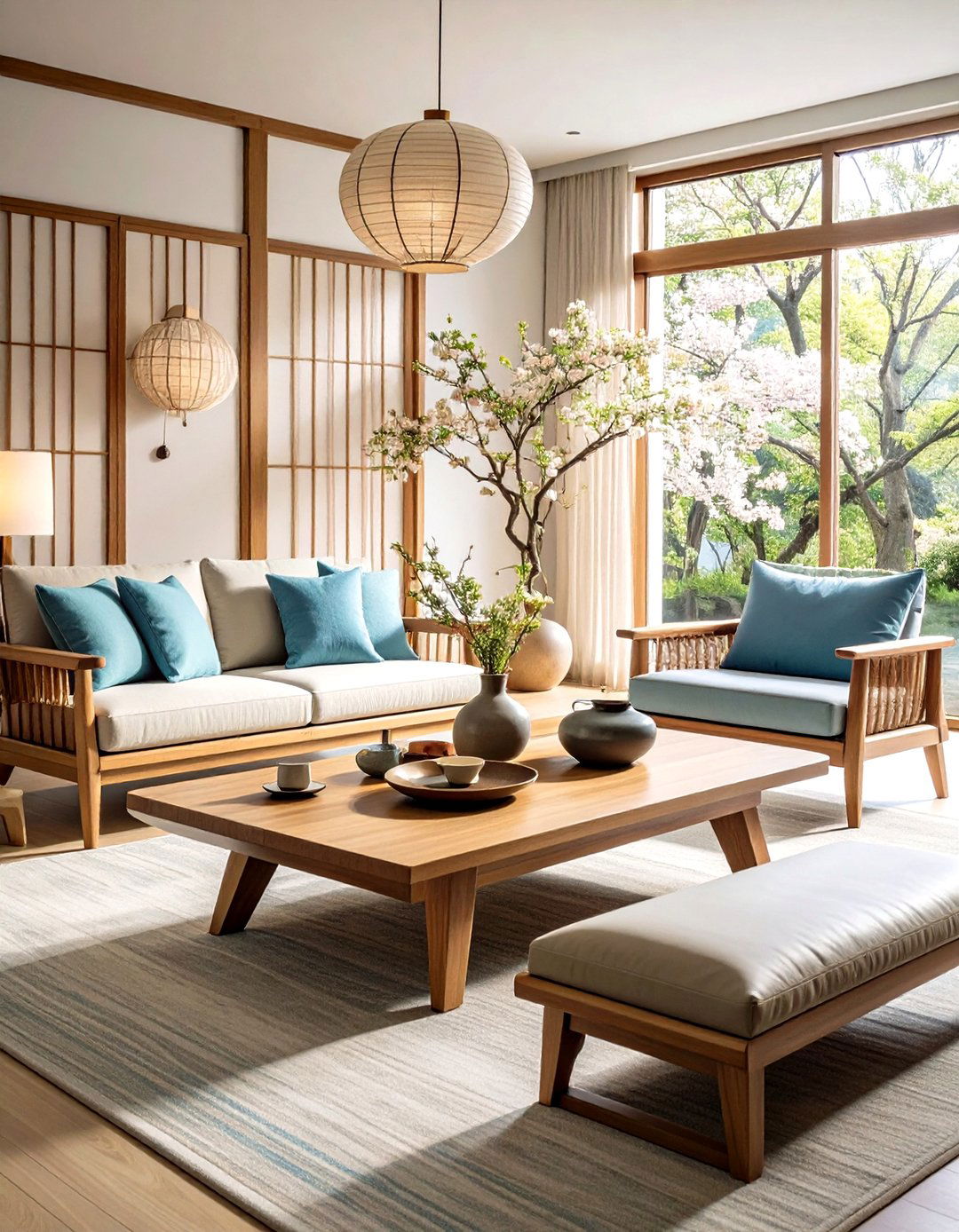
Select furniture pieces that perfectly blend Nordic functionality with Japanese elegance for authentic Japandi appeal. Choose a solid oak coffee table with clean lines and visible wood grain paired with Scandinavian-style armchairs featuring curved backs. Can furniture truly tell the story of two design cultures in perfect harmony? Add a Japanese-inspired low bench with leather cushioning for flexible seating options. Look for pieces that showcase expert craftsmanship and natural materials without excessive ornamentation. The key lies in selecting items that serve multiple purposes while maintaining visual simplicity. These fusion pieces create conversation starters while honoring both design traditions. Every furniture selection should emphasize quality over quantity, ensuring your living room feels thoughtfully curated rather than simply furnished with beautiful, functional pieces.
7. Indoor Plant Integration
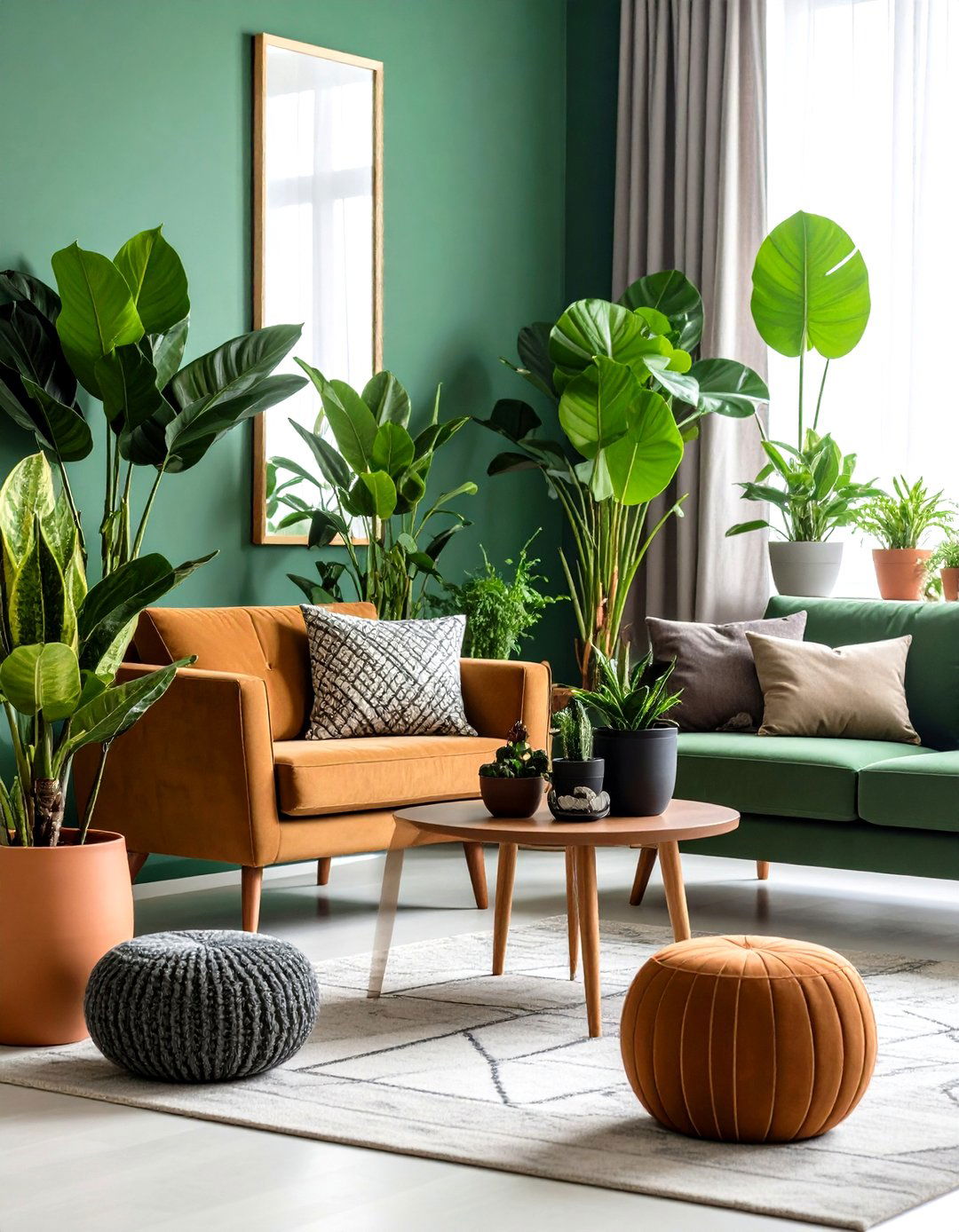
Bring life and natural beauty into your Japandi living room through carefully selected greenery that complements the minimalist aesthetic. Choose plants with architectural forms like snake plants, fiddle leaf figs, or Japanese peace lilies in simple ceramic planters. How do living plants create such powerful connections between indoor and outdoor spaces? Position larger plants in corners to soften hard architectural lines while smaller specimens can accent shelves and side tables. Select planters in neutral tones like terracotta, matte black, or natural stone to maintain design cohesion. Avoid busy patterns or bright colors that compete with your serene palette. These green elements purify air while adding organic shapes and subtle color variations that celebrate nature's imperfect beauty throughout your peaceful living space.
8. Functional Storage Solutions
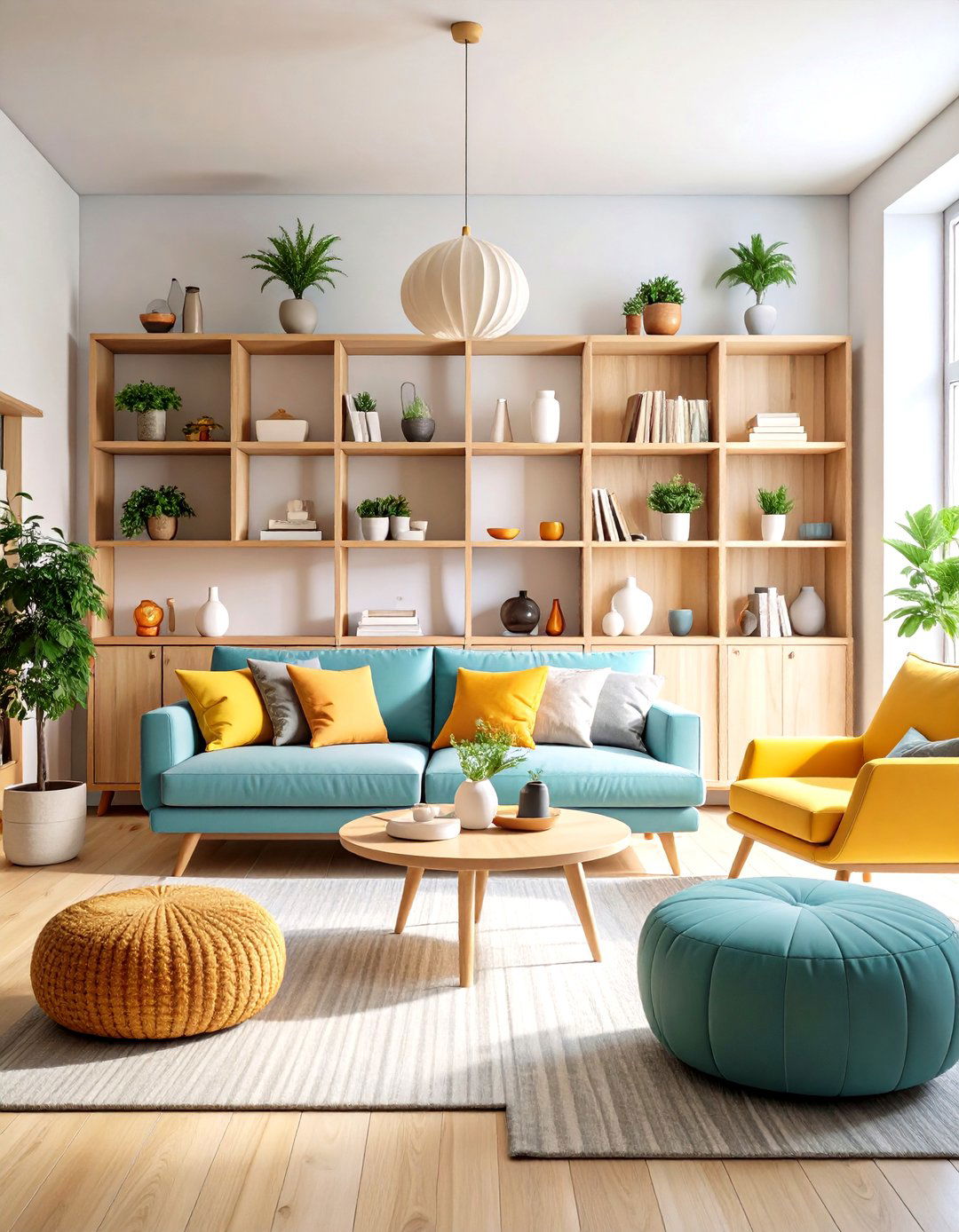
Maximize your living space with storage solutions that maintain the clean, uncluttered aesthetic essential to Japandi design. Install floating shelves in light wood to display carefully curated objects while keeping surfaces clear. What happens when storage becomes an integral part of your room's beautiful design? Choose ottomans with hidden compartments for storing blankets and magazines out of sight. Consider built-in cabinetry with smooth, handleless doors that blend seamlessly into your walls. Select storage pieces that serve multiple functions, like benches with internal storage or coffee tables with drawer space. Every storage solution should feel intentional and aesthetically pleasing rather than purely utilitarian. This approach ensures your living room remains serene while accommodating all your daily needs through thoughtful, beautiful organization.
9. Warm White Paint Palette
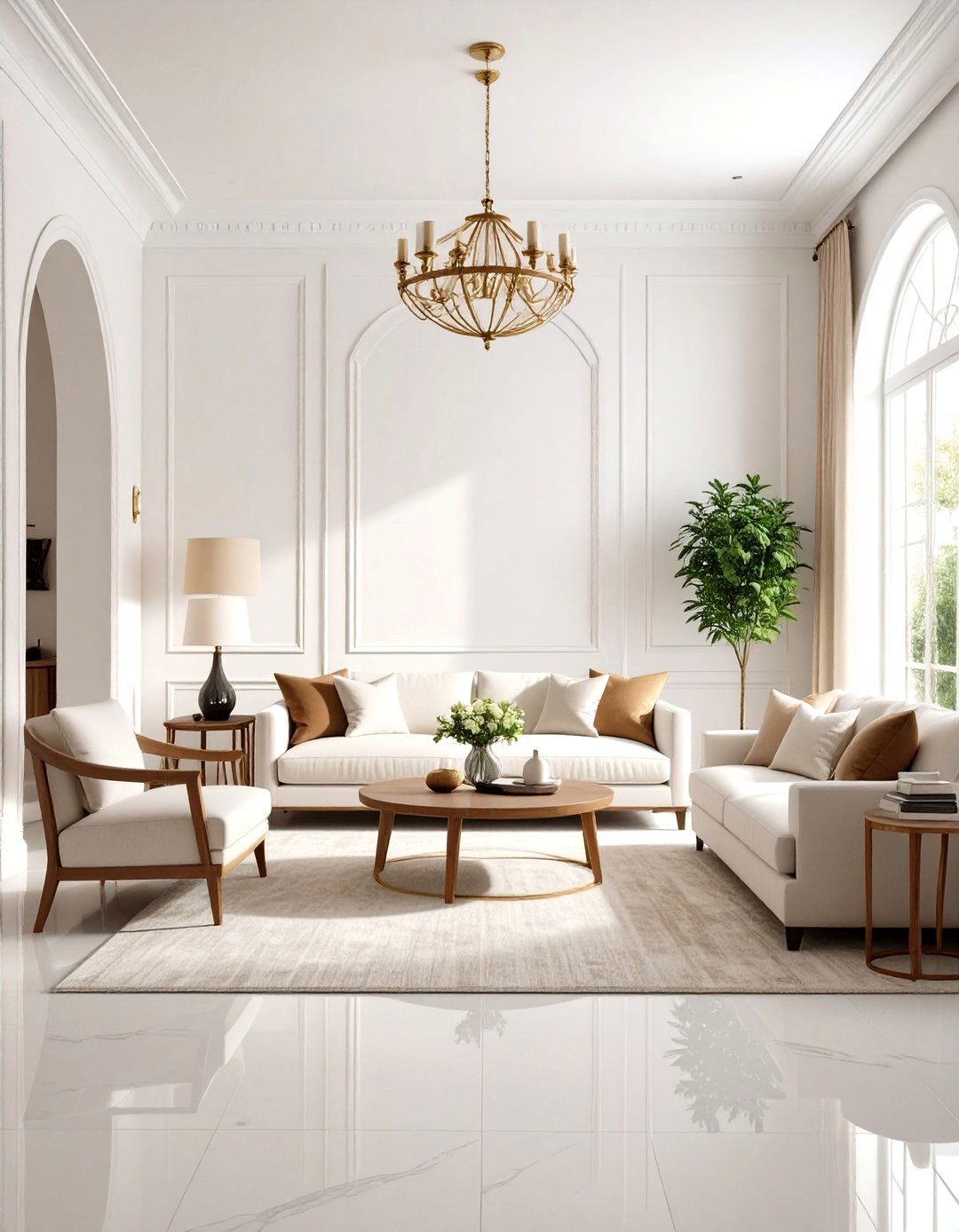
Create an inviting atmosphere with carefully chosen warm white paint tones that form your living room's serene backdrop. Select colors like Creamy White or Soft Stone that prevent stark, cold feelings while maintaining brightness and openness. Can the right white paint actually make your room feel like a warm embrace? These nuanced whites reflect natural light beautifully throughout different times of day while providing a neutral canvas for your furniture and decor. Consider painting trim and molding in slightly contrasting whites to add subtle architectural definition. The warm undertones in these paint choices complement natural wood furniture and create cohesion with earth-toned accessories. This foundation allows other design elements to shine while maintaining the peaceful, minimalist atmosphere that defines authentic Japandi living spaces perfectly.
10. Rattan and Wicker Accents
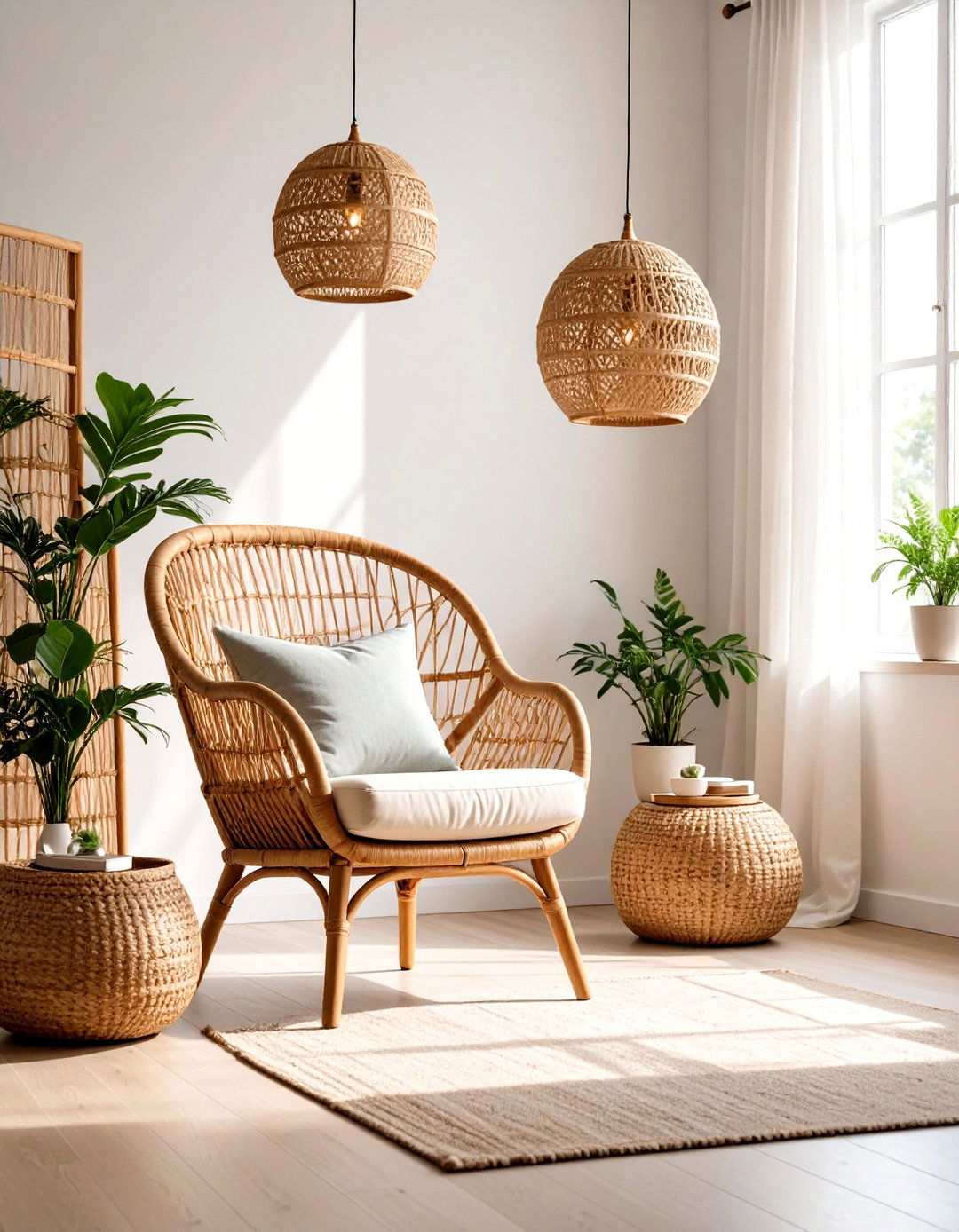
Incorporate natural rattan and wicker elements that add organic texture and warmth to your minimalist living room. Choose a statement rattan armchair with clean lines paired with wicker storage baskets for stylish organization. How do these natural materials create such inviting, lived-in feelings in modern spaces? Add a wicker room divider to define spaces without blocking light flow in open-plan layouts. Select pieces with tight, consistent weaving patterns for a more refined appearance that aligns with Japandi aesthetics. These materials develop beautiful patina over time, celebrating the wabi-sabi appreciation for natural aging and imperfection. Position rattan pendant lights or floor lamps to cast interesting shadow patterns on walls. The natural variations in these handcrafted materials add personality while maintaining the calm, grounded feeling essential to your peaceful sanctuary.
11. Floor Cushion Seating
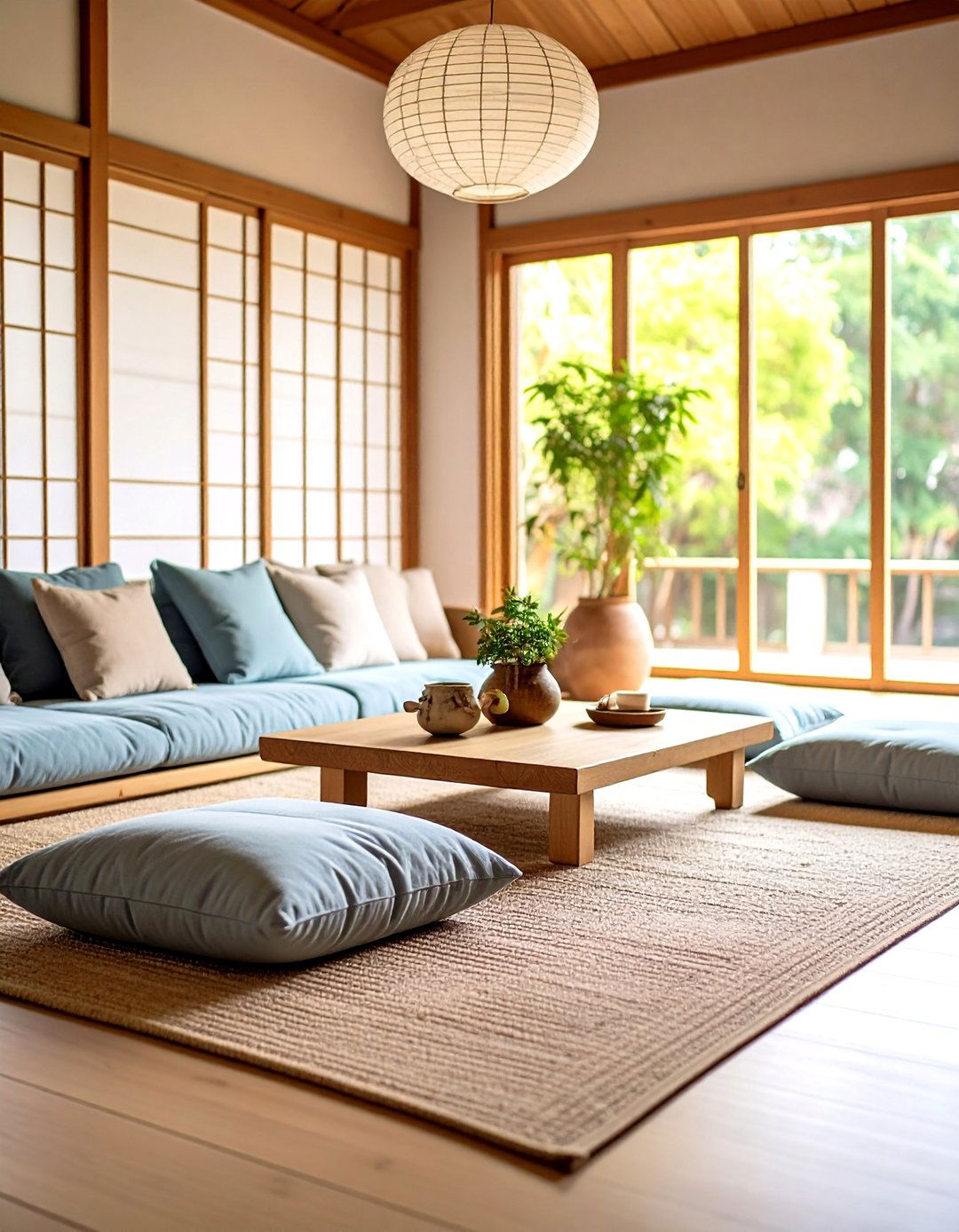
Embrace traditional Japanese seating customs with floor cushions that create intimate, flexible living arrangements. Select large zabuton cushions in natural linen or cotton fabrics arranged around a low coffee table for casual dining and conversation. What unique sense of connection emerges when we bring our living closer to the earth? Layer different sizes and neutral tones to create visual interest while maintaining comfort for extended sitting. Add a few meditation cushions in hemp fabric for quiet contemplation moments. This seating style encourages mindful postures and creates opportunities for more intimate gatherings. Choose cushions with removable, washable covers for practical maintenance. The flexibility of floor seating allows easy room reconfiguration while honoring Japanese traditions that emphasize simplicity, mindfulness, and connection with natural elements in daily living.
12. Natural Stone Elements
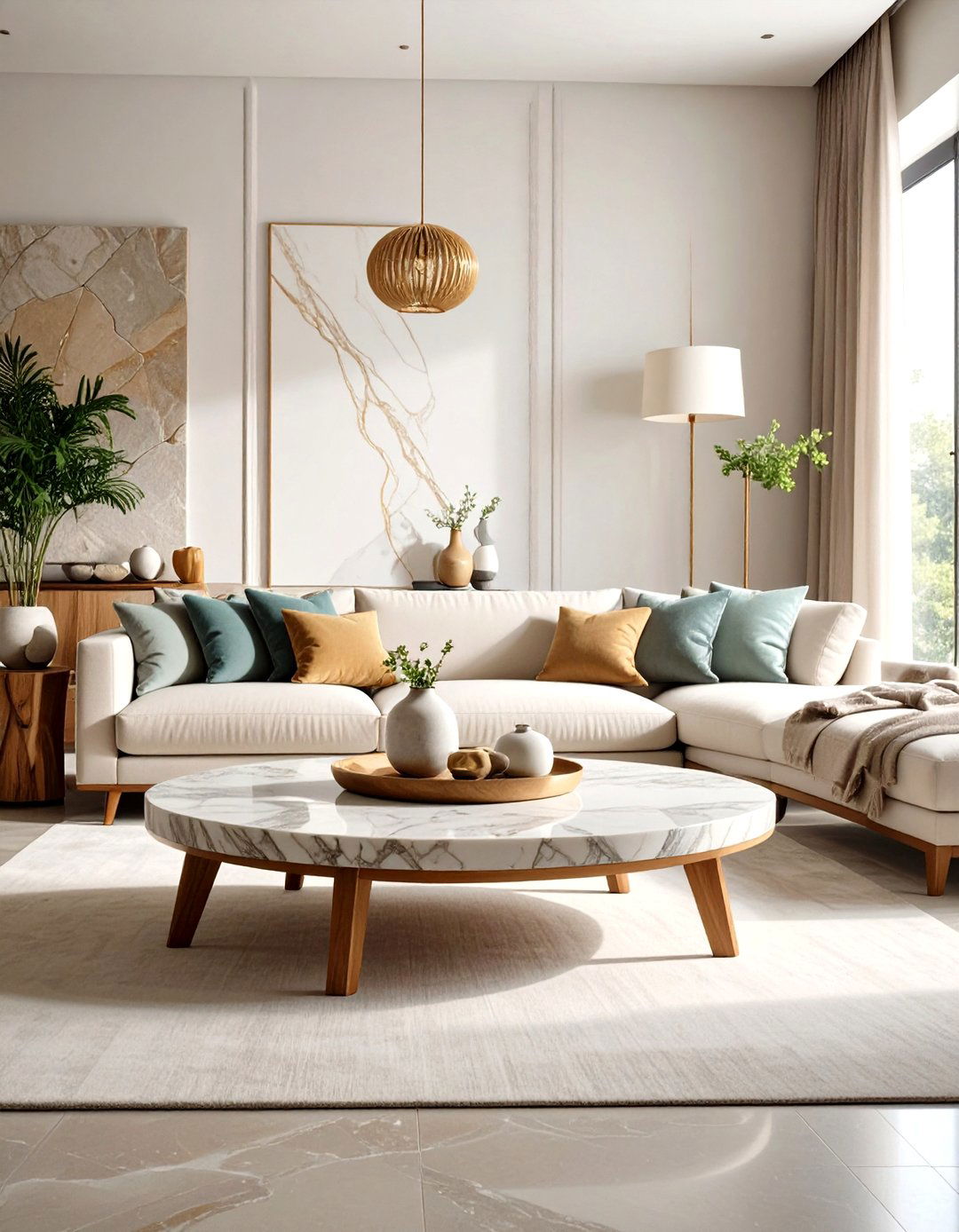
Introduce grounding stone elements that add sophisticated texture and connect your living room to natural landscapes. Select a coffee table with a marble or slate top paired with wooden legs for material contrast. Can natural stone actually anchor your entire room's energy and create lasting serenity? Add stone bookends on floating shelves or choose decorative bowls carved from smooth river rocks. Consider a stone accent wall using stacked slate or natural fieldstone for dramatic texture without overwhelming patterns. These elements celebrate imperfection and natural variation while providing cool contrast to warm wood tones. Position stone sculptures or geometric forms as conversation pieces that embody minimalist art principles. The permanence and weight of stone creates psychological grounding while adding sophisticated neutral tones to your carefully curated color palette.
13. Monochrome Wall Art
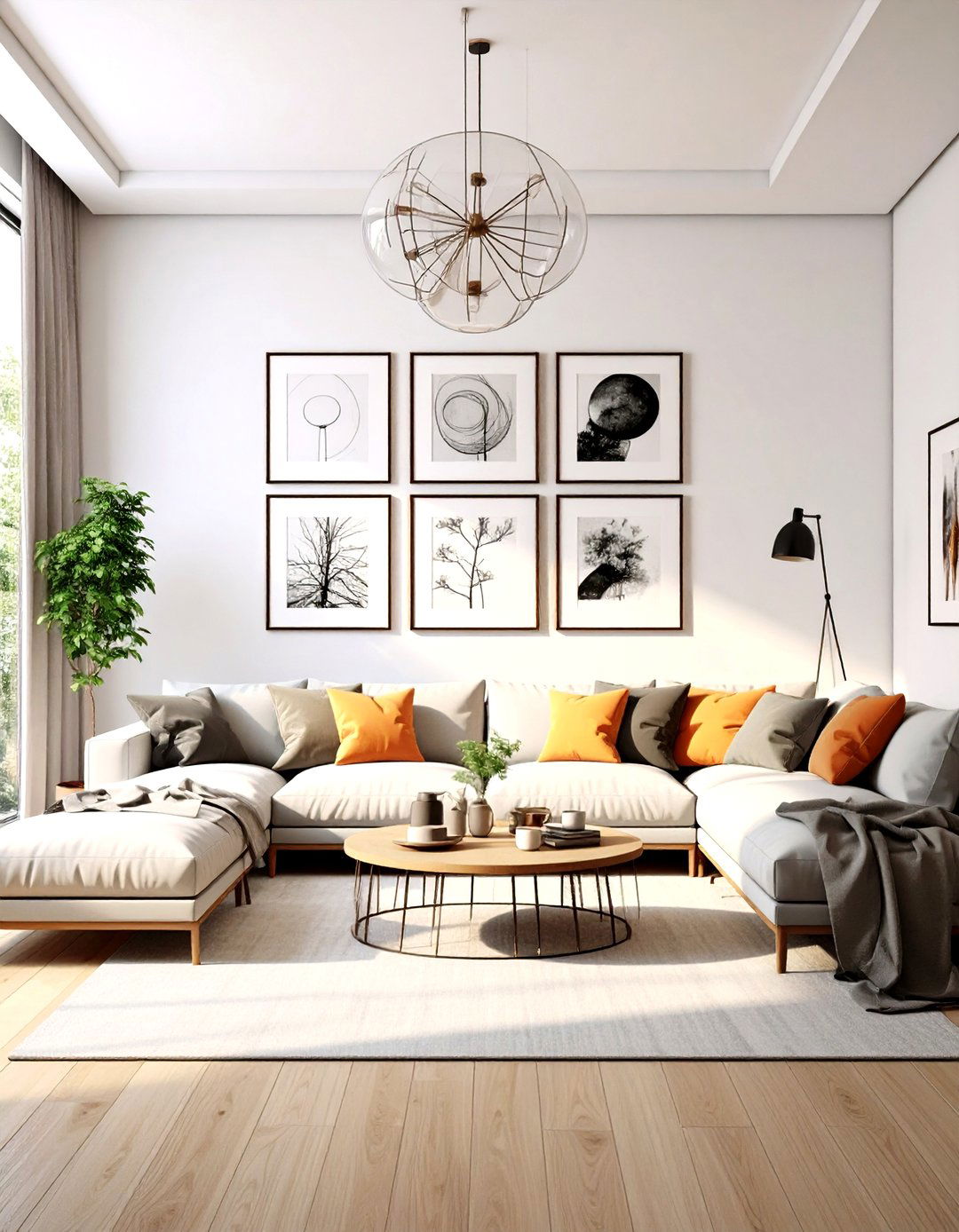
Curate a gallery wall featuring black and white photography or minimalist line drawings that complement your Japandi aesthetic without overwhelming the space. Select pieces with nature themes like abstract landscapes, botanical studies, or architectural details in simple frames. How can monochrome art create such powerful emotional resonance in minimalist interiors? Choose varying sizes but maintain consistent framing materials like matte black or natural wood for cohesion. Leave generous white space between pieces to prevent visual clutter and allow each artwork to breathe. Consider Japanese calligraphy or Scandinavian graphic prints that honor both cultural influences. Position artwork at eye level and use proper lighting to highlight textures and details. This restrained approach to wall decoration maintains the serene atmosphere while adding personality and cultural depth to your thoughtfully designed living space.
14. Bamboo Design Features
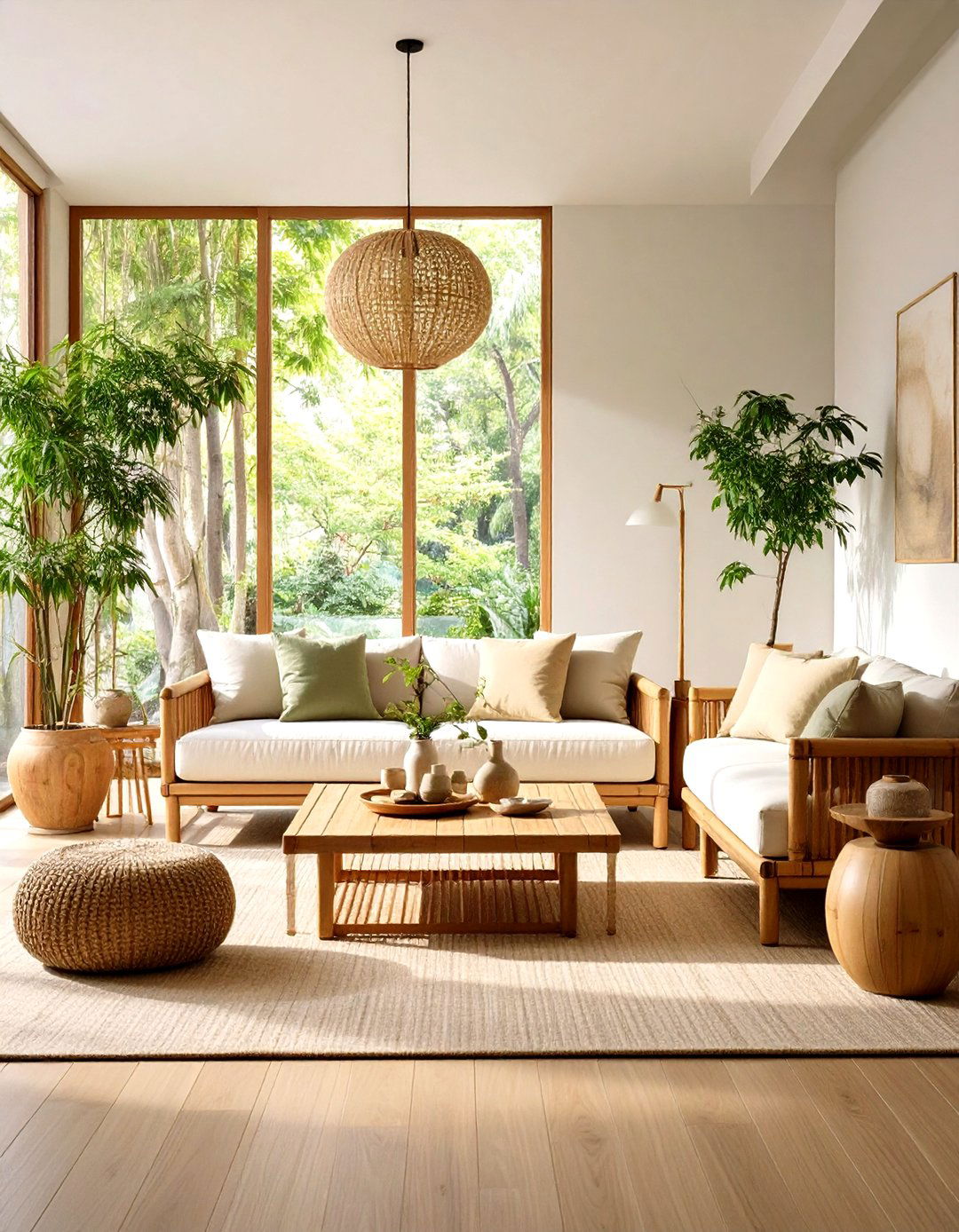
Incorporate sustainable bamboo elements that bring natural beauty and environmental consciousness to your Japandi living room. Choose bamboo furniture pieces like side tables or plant stands that showcase the material's natural nodes and grain patterns. What makes bamboo such a perfect bridge between Japanese tradition and modern sustainability values? Add bamboo blinds or room dividers that filter light while maintaining privacy and visual interest. Consider decorative bamboo poles arranged in tall ceramic vases for sculptural elements that emphasize vertical lines. The material's rapid growth and renewability align with sustainable living principles while providing warm, honey-colored tones that complement neutral palettes. Bamboo's natural flexibility and strength represent resilience and adaptability, qualities that resonate with both Japanese philosophy and Scandinavian practicality in creating harmonious, environmentally conscious living spaces.
15. Cozy Reading Nook
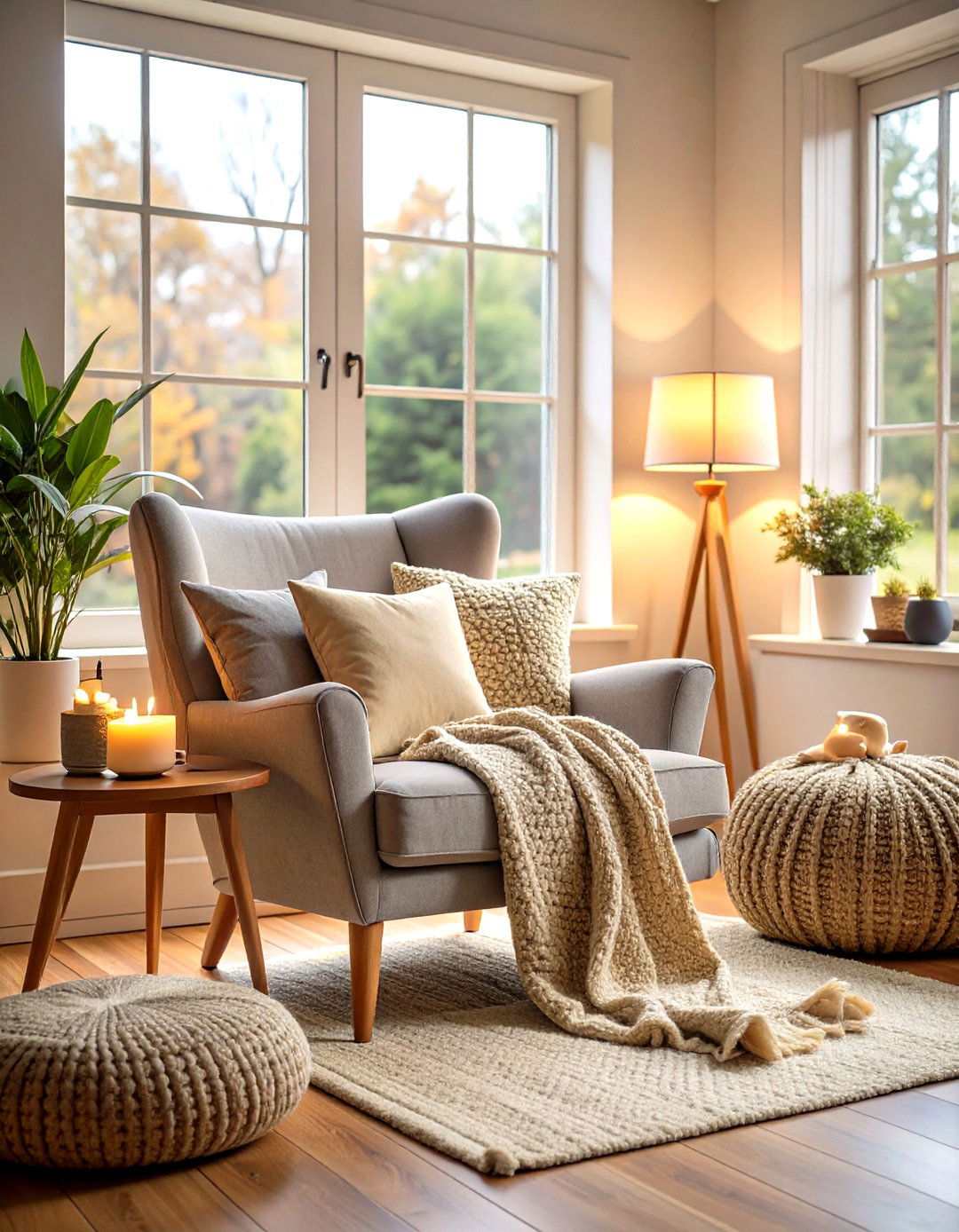
Design a dedicated reading corner that embodies hygge comfort within your minimalist living room framework. Position a comfortable armchair near a window with a small side table for books and tea. How does creating a special reading space transform your entire relationship with your living room? Add a soft throw blanket and reading pillow in neutral tones for ultimate comfort during long reading sessions. Install adjustable task lighting that provides proper illumination without disturbing other room activities. Include a small bookshelf or floating shelves nearby to keep current reads within easy reach. Choose furniture with ergonomic design that supports extended sitting while maintaining aesthetic appeal. This dedicated space encourages mindful relaxation and creates a personal retreat within your shared living area, perfectly balancing the Japandi principles of functionality and serene beauty.
16. Floating Shelves Display
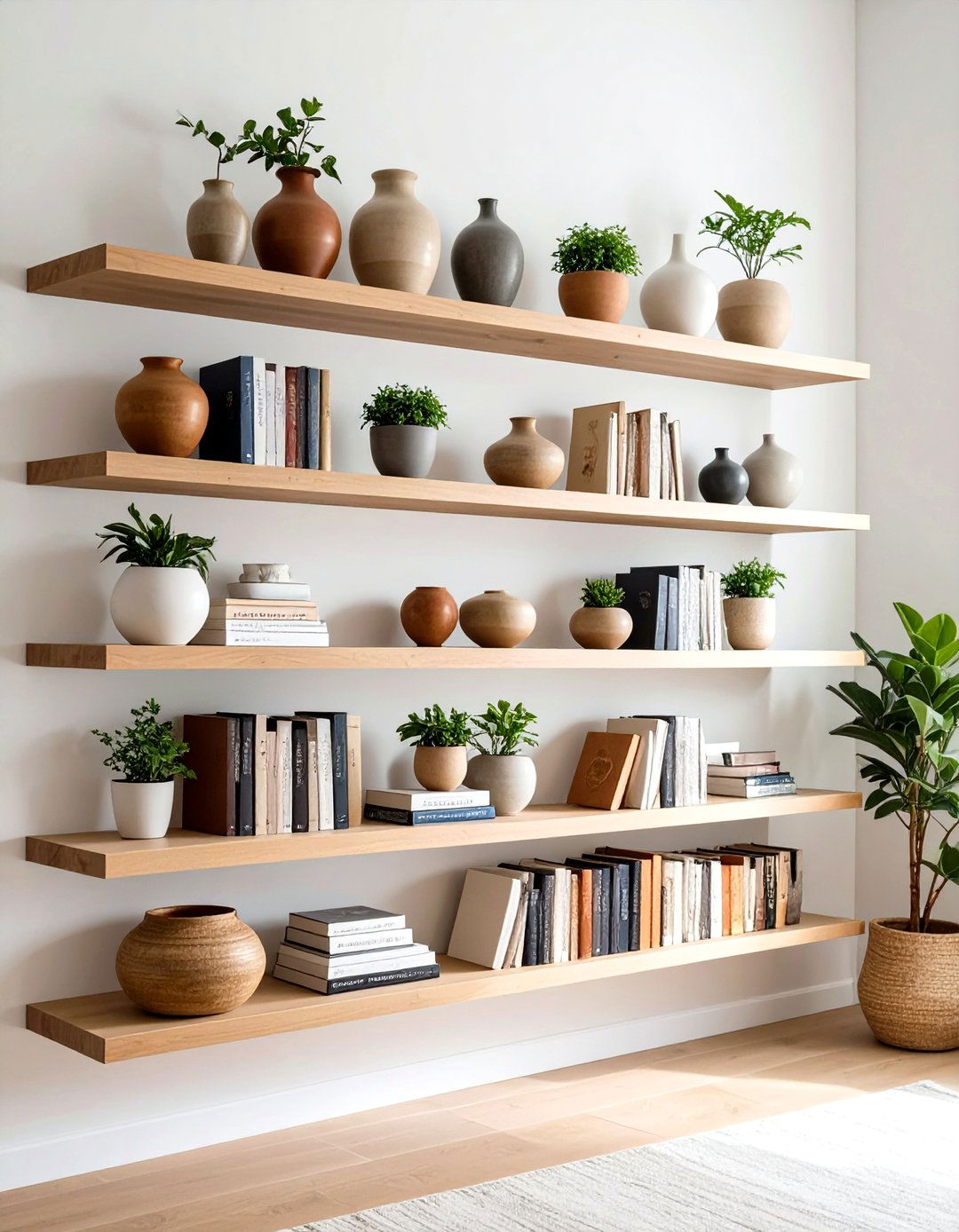
Create elegant storage and display opportunities with floating shelves that maintain clean lines while showcasing carefully chosen objects. Install light wood shelves at varying heights to create visual rhythm without overwhelming the wall space. What transforms ordinary wall storage into artful display that enhances your room's serenity? Arrange ceramic vessels, small plants, and minimal books with plenty of breathing room between items. Choose objects in your neutral color palette to maintain cohesion while adding textural interest through different materials. Keep displays sparse and rotate items seasonally to prevent visual fatigue. Consider asymmetrical arrangements that feel organic rather than rigidly structured. The floating design maintains the illusion of weightlessness while providing practical storage for everyday items and treasured objects that reflect your personal aesthetic within the greater Japandi design framework.
17. Earthy Accent Colors
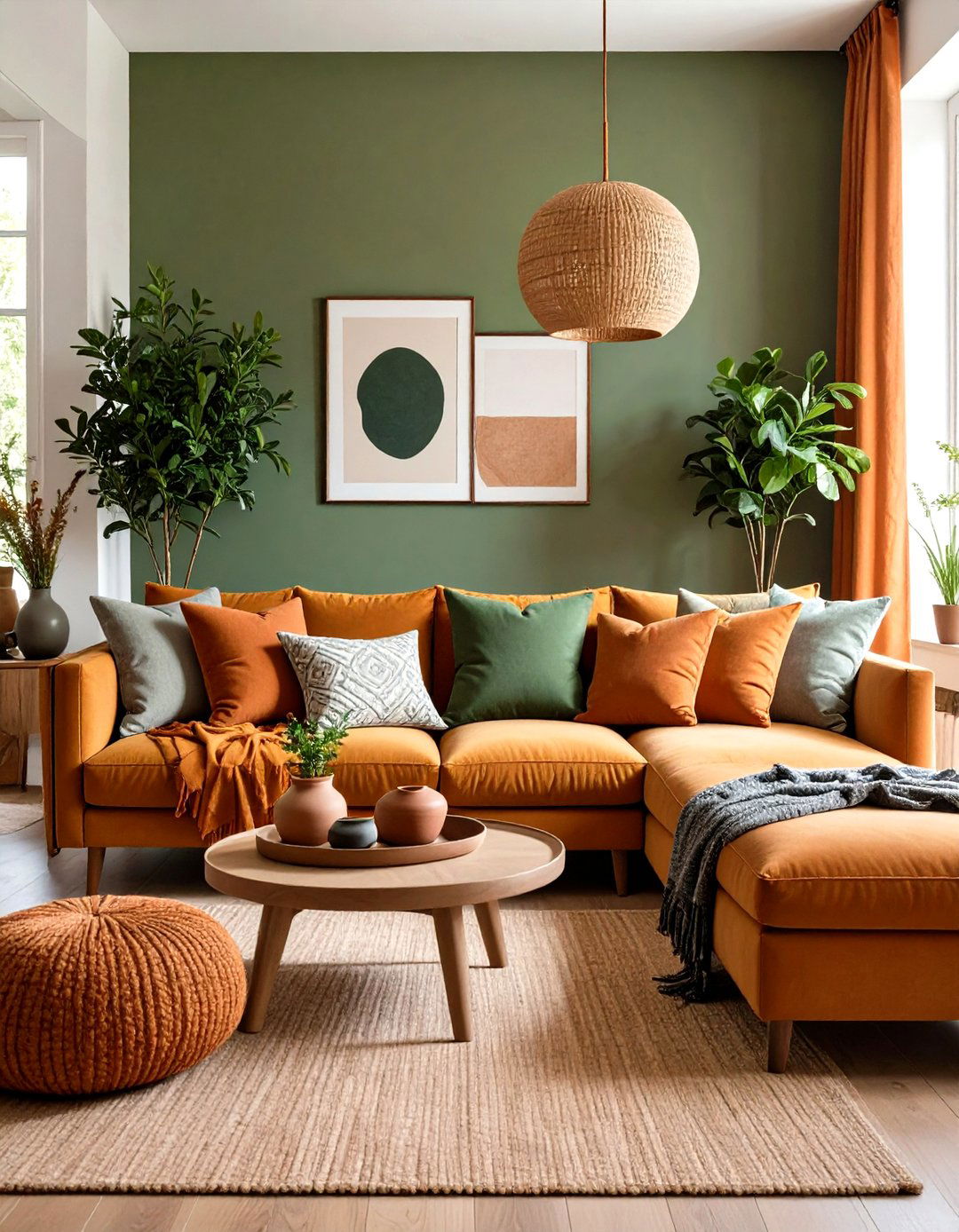
Introduce subtle earth tones that add warmth and depth to your neutral foundation without disrupting the serene atmosphere. Select sage green, warm terracotta, or soft mushroom gray for accent pillows, artwork, or ceramic pieces. How do these grounded colors create such profound connections to natural landscapes indoors? Use these hues sparingly through textiles like throw blankets or small decorative objects to prevent overwhelming the space. Consider seasonal rotation of accent colors to keep your living room feeling fresh and connected to natural cycles. These earthy tones pair beautifully with natural wood and stone elements while maintaining the sophisticated simplicity that defines Japandi design. The key lies in restraint and intention, allowing these natural colors to enhance rather than dominate your carefully curated neutral palette for lasting visual harmony.
18. Organic Shape Furniture
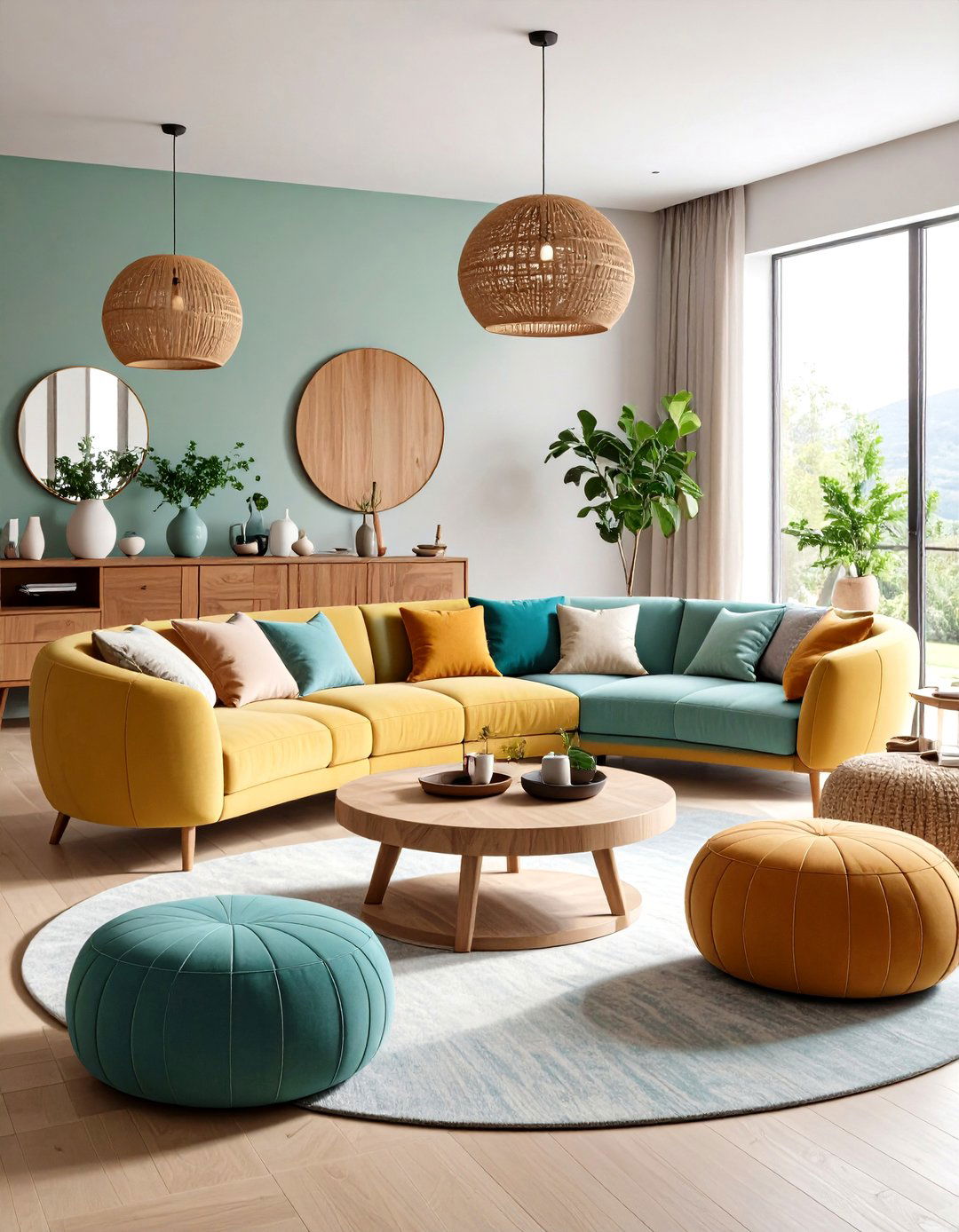
Select furniture with curved, organic forms that soften the clean geometric lines typical in minimalist design. Choose a round coffee table, curved sofa, or kidney-shaped ottoman that creates visual flow and comfort. What happens when furniture mimics the gentle curves found throughout the natural world? These softer shapes create more inviting, approachable feelings while maintaining the sophisticated simplicity essential to Japandi aesthetics. Look for pieces that combine organic forms with natural materials like solid wood or woven fibers. Avoid furniture with sharp corners or aggressive angles that might create visual tension in your peaceful space. The organic approach reflects both Japanese appreciation for natural forms and Scandinavian emphasis on human comfort and functionality. This thoughtful selection creates a living room that feels harmonious and welcoming while maintaining the refined elegance characteristic of authentic Japandi design.
19. Tatami Mat Flooring
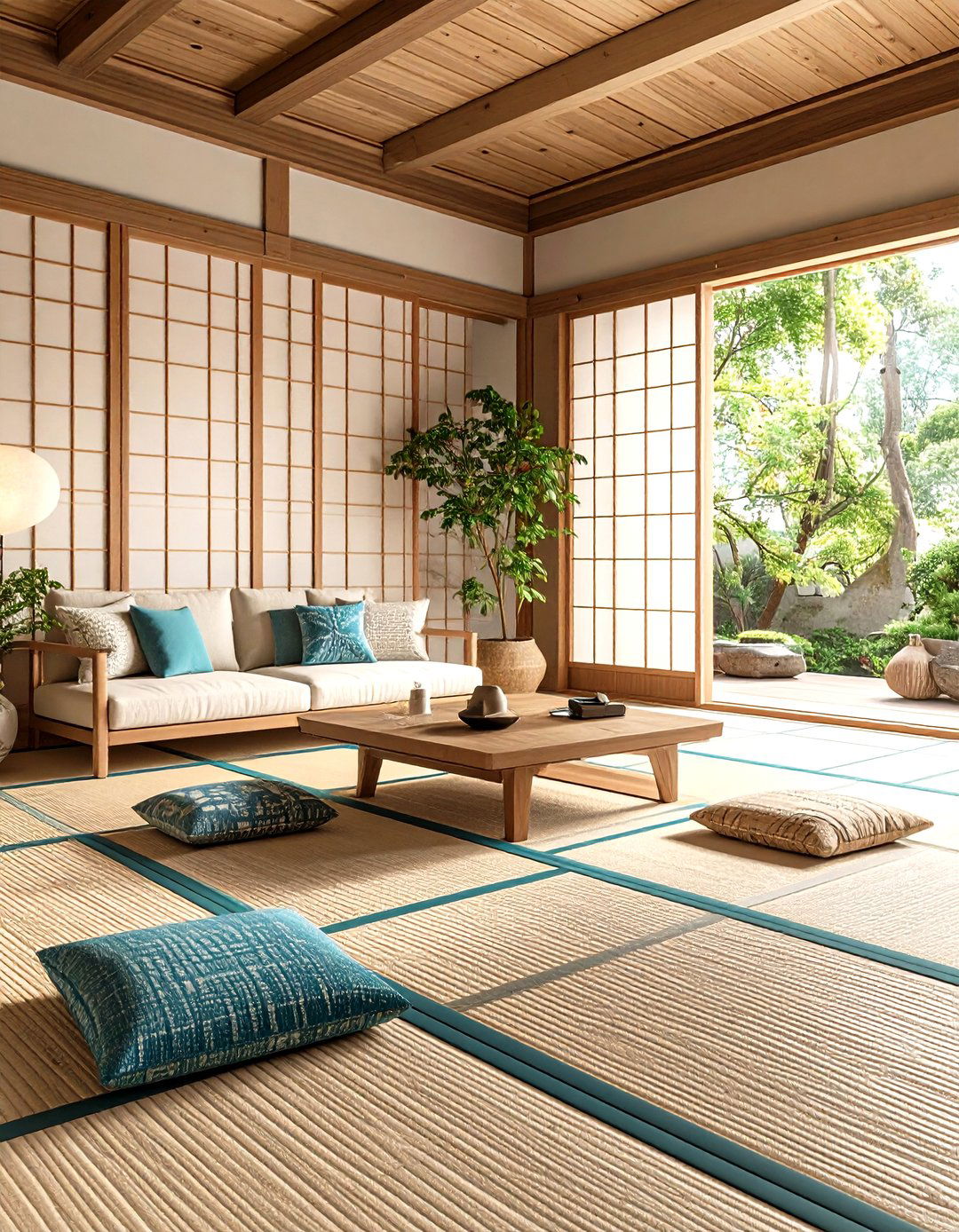
Honor Japanese traditions by incorporating tatami-inspired flooring elements that add texture and cultural authenticity to your living room. Use natural fiber rugs or mat-style flooring that creates defined seating areas while providing comfort underfoot. Can traditional flooring materials actually enhance modern minimalist living spaces so dramatically? Layer different sizes of woven mats to create visual interest while maintaining the clean, geometric patterns typical of tatami design. Choose neutral colors that complement your overall palette while adding subtle texture variations. These natural fiber elements provide insulation and acoustic benefits while connecting your space to centuries-old Japanese design wisdom. Position mats strategically to define conversation areas or meditation spaces within your larger living room. The regular grid patterns of tatami-inspired flooring create order and calm while honoring traditional craftsmanship and natural materials.
20. Paper Lantern Lighting
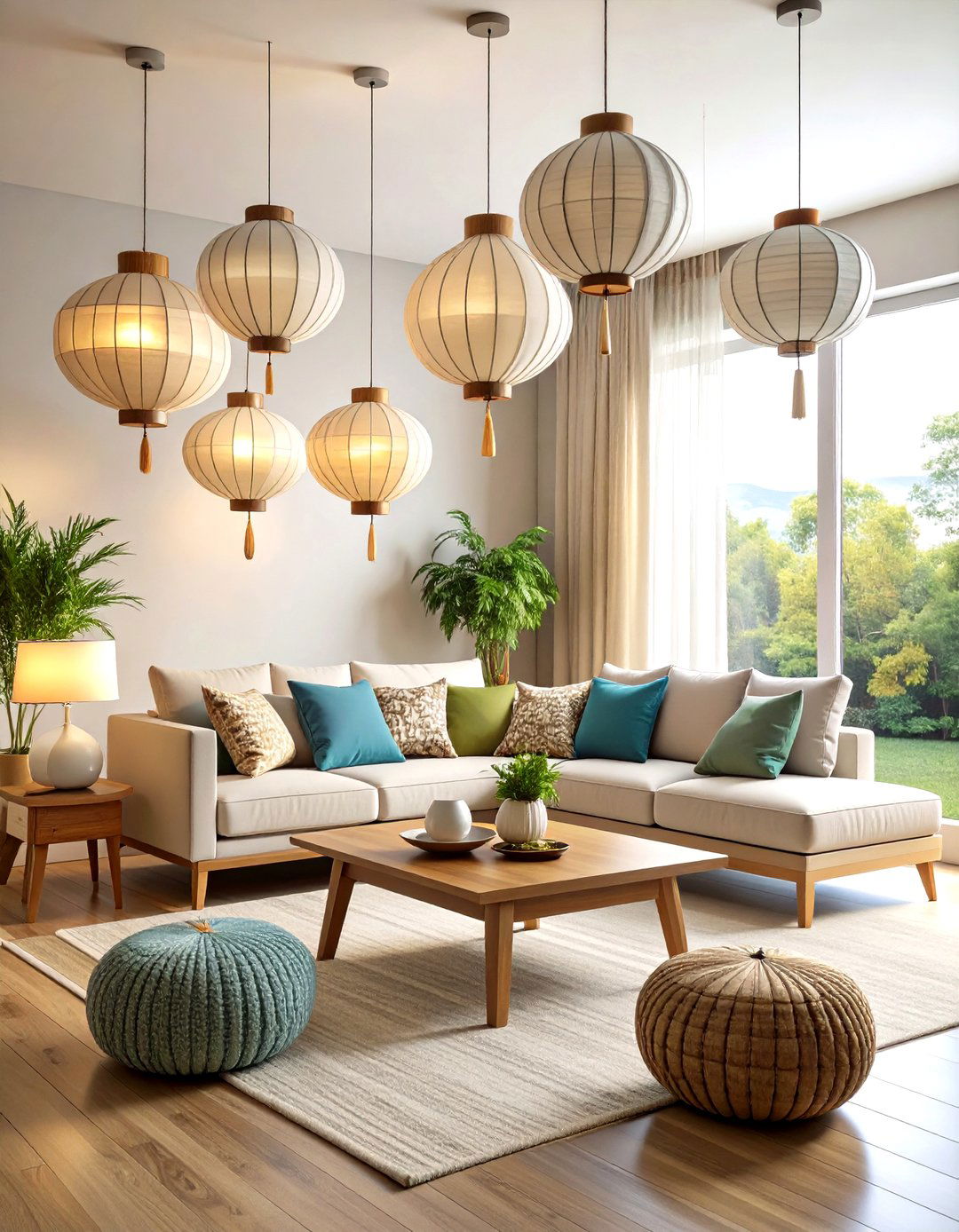
Create ambient lighting with paper lanterns that honor Japanese design traditions while providing soft, diffused illumination. Choose simple geometric shapes in white or natural colors that complement your minimalist aesthetic. How can traditional lighting fixtures transform modern spaces into serene, temple-like sanctuaries? Position pendant lanterns at varying heights to create visual interest without overwhelming your clean design lines. The translucent paper material filters harsh light beautifully, creating warm, inviting glows perfect for evening relaxation. Select lanterns with minimal decorative elements that focus on pure form and function. These lightweight fixtures can be easily repositioned for flexible lighting arrangements during different activities. The handcrafted quality of paper lanterns adds authentic cultural elements while maintaining the sophisticated simplicity that defines your Japandi living room's peaceful, welcoming atmosphere throughout day and night.
21. Ceramic Decor Elements
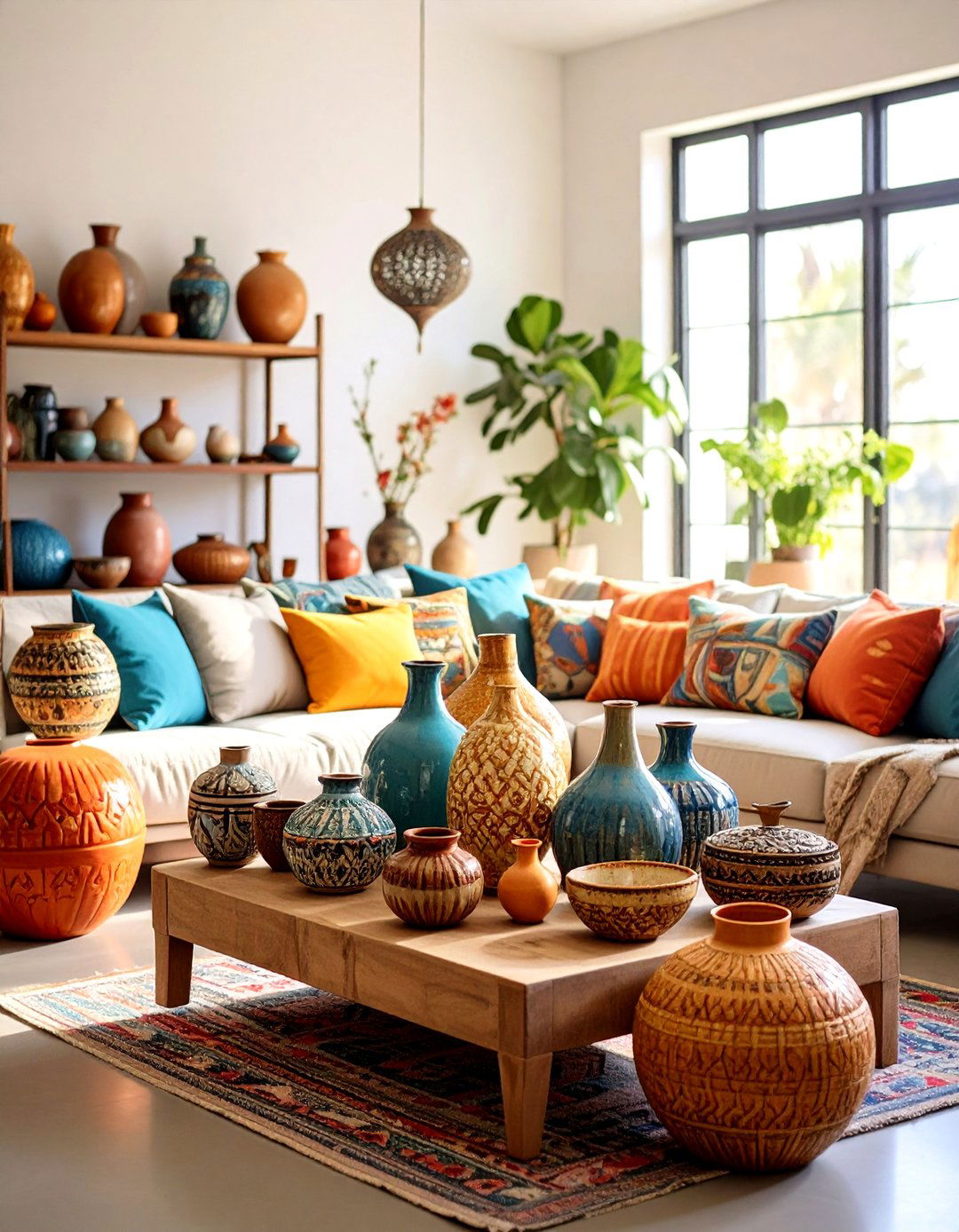
Showcase handcrafted ceramic pieces that celebrate imperfection and artisanal beauty throughout your minimalist living space. Select vases, bowls, and decorative objects with subtle glazes in earth tones or matte finishes. What makes ceramic art such powerful expression of wabi-sabi philosophy in modern interiors? Choose pieces with organic shapes and visible evidence of the potter's hand for authentic handmade character. Group objects in odd numbers with varying heights to create pleasing arrangements on shelves and side tables. The natural variations in handmade ceramics prevent the sterile perfection that can make minimalist spaces feel cold. Consider functional ceramic pieces like tea sets or serving bowls that honor both beauty and utility. These thoughtful selections add personality and cultural depth while maintaining the refined aesthetic that makes your Japandi living room feel both sophisticated and warmly welcoming.
22. Linen and Cotton Textiles
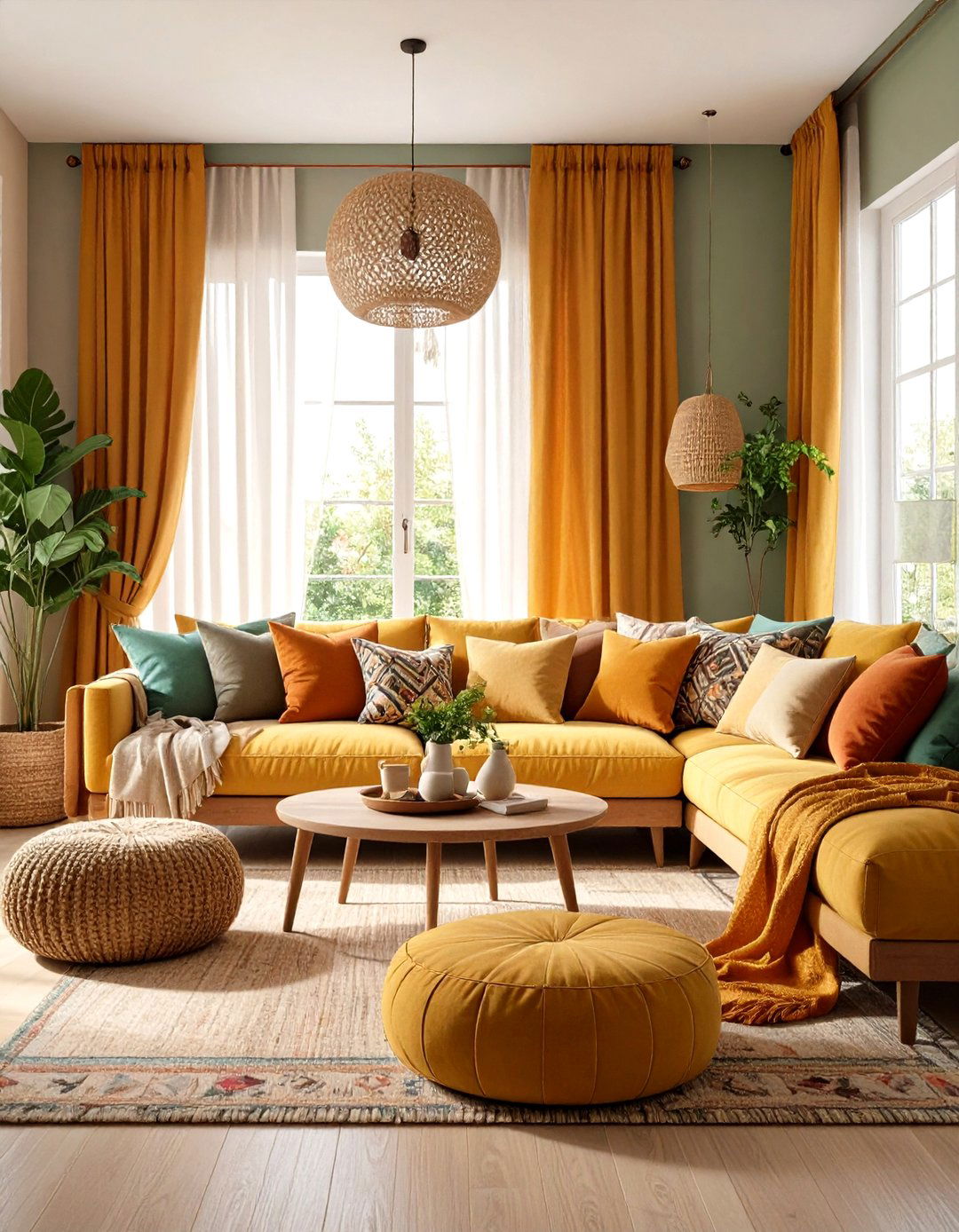
Layer natural fabric textiles that add softness and warmth while maintaining the clean, unprocessed aesthetic essential to Japandi design. Choose linen curtains in warm white or soft gray that filter natural light beautifully throughout your living space. How do natural textiles create such inviting, comfortable atmospheres in minimalist room settings? Add cotton throw pillows in varying neutral tones and subtle textures for comfortable accents on your seating furniture. Select fabrics with visible weaves or subtle irregularities that celebrate natural fiber characteristics rather than hiding them. Avoid synthetic materials that lack the authentic feel and aging qualities of natural textiles. These organic fabrics develop beautiful patina over time while providing practical comfort for daily living. The key lies in choosing quality pieces that will improve with age and use, embodying sustainable design principles.
23. Zen Garden Corner
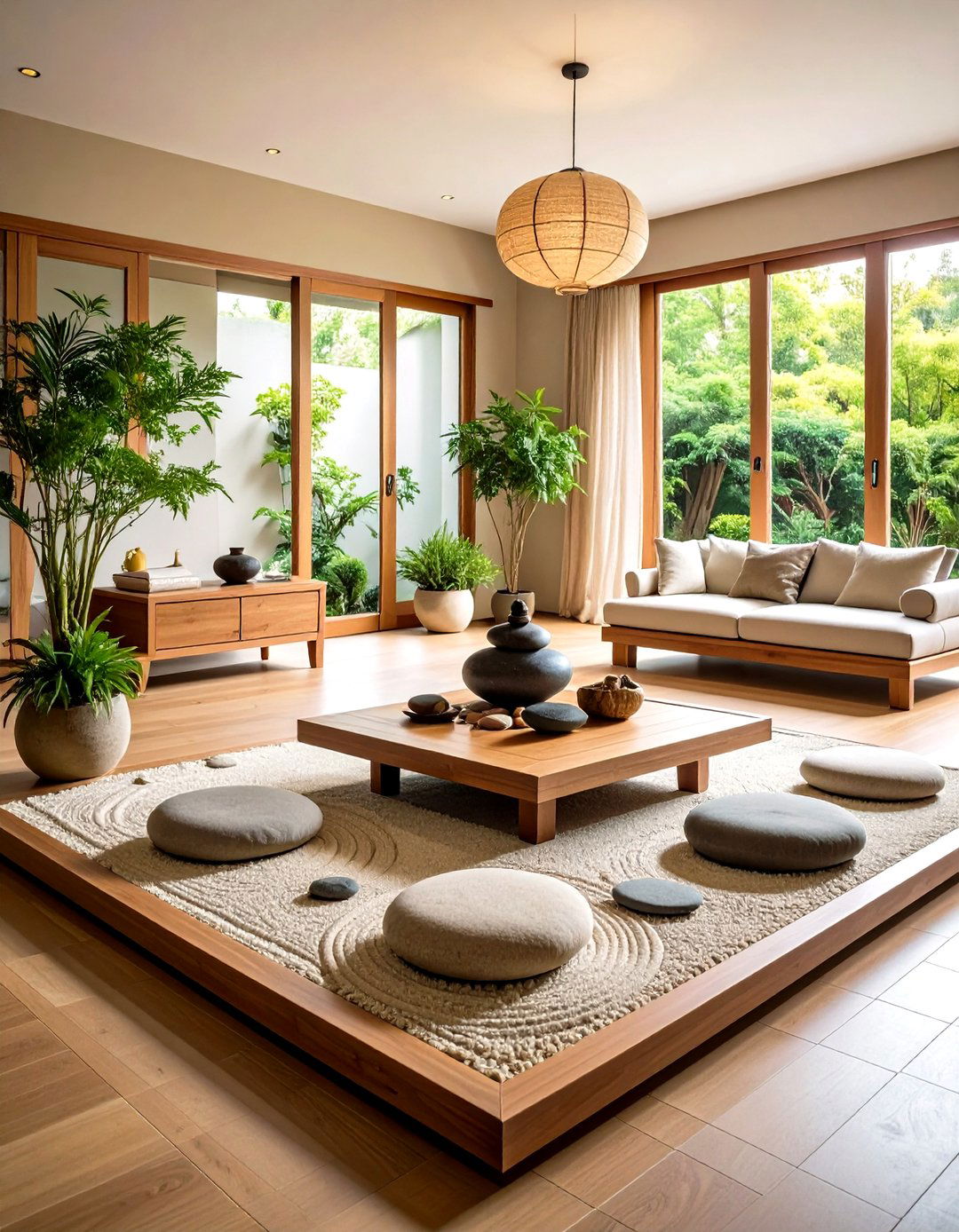
Create a meditative corner that brings Japanese garden principles indoors through carefully arranged natural elements and peaceful design. Position a low wooden platform with sand, smooth stones, and a single sculptural plant or branch arrangement. What profound sense of calm emerges when we bring contemplative garden elements into our living spaces? Add a comfortable meditation cushion nearby for quiet reflection and mindfulness practice. Choose a corner with good natural light but away from high-traffic areas to maintain tranquility. Include a small water feature or wind chime for gentle sound elements that enhance the peaceful atmosphere. This dedicated space encourages daily meditation and provides visual rest within your living room's functional areas. The zen garden corner represents the perfect marriage of Japanese spiritual practice and Scandinavian appreciation for nature's restorative power in modern living.
24. Multi-functional Furniture
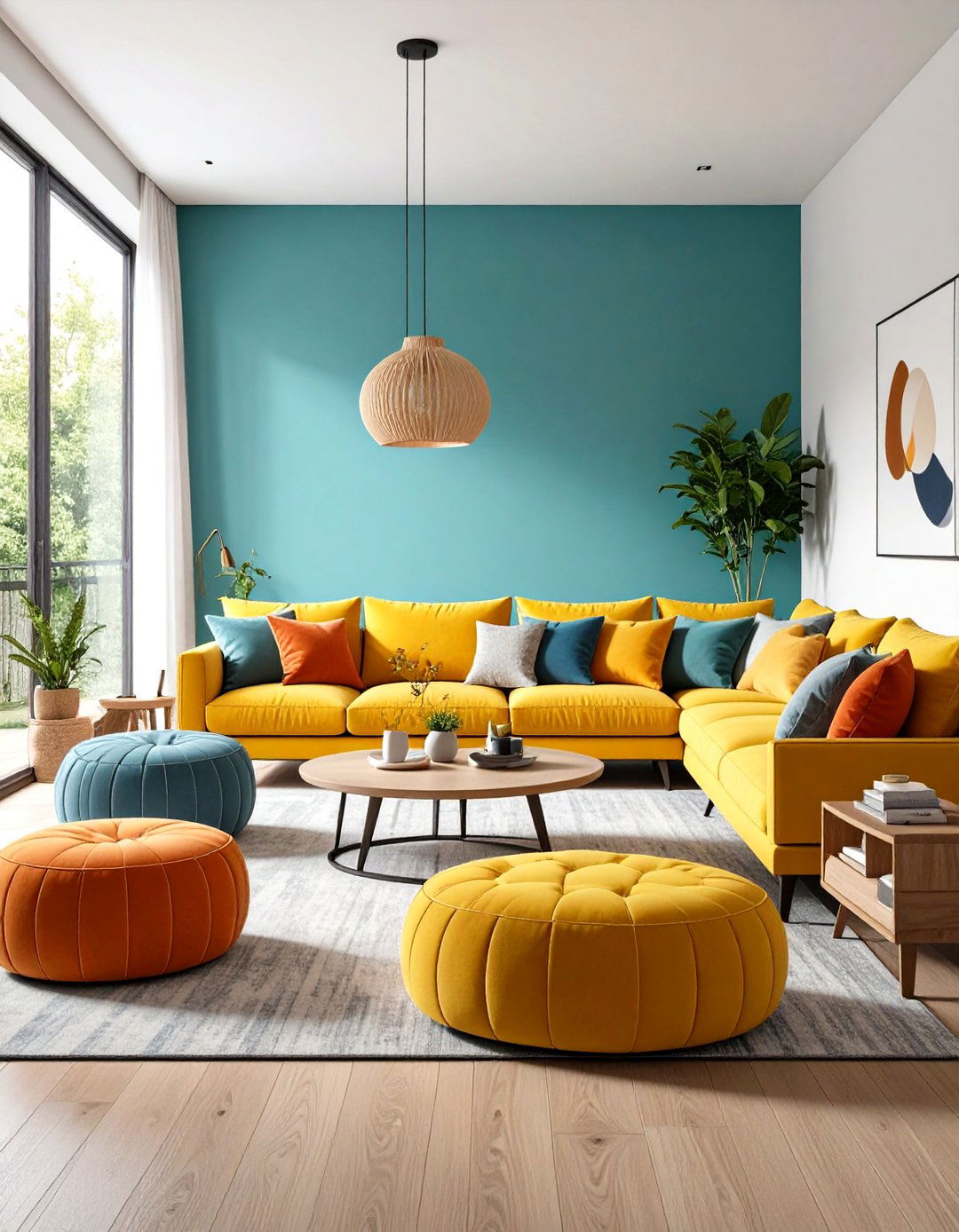
Maximize your living space efficiency with furniture pieces that serve multiple purposes while maintaining sophisticated aesthetic appeal. Choose ottomans with internal storage, expandable dining tables, or modular seating that adapts to different needs throughout your day. Can furniture actually simplify your life while making your living room more beautiful and functional? Select pieces that transition seamlessly between different functions without compromising design integrity or visual appeal. Look for hidden storage compartments, convertible surfaces, or stackable elements that reduce clutter while providing practical solutions. These thoughtful selections honor both Japanese space efficiency and Scandinavian functionality in creating harmonious living environments. Quality construction ensures these multipurpose pieces will serve your changing needs for years while maintaining the refined simplicity that defines authentic Japandi design philosophy throughout your peaceful, purposeful living space.
Conclusion:
Creating an authentic Japandi living room requires thoughtful balance between minimalist principles and warm comfort, resulting in spaces that nurture both body and soul. These twenty-four design ideas demonstrate how Japanese mindfulness and Scandinavian coziness can merge seamlessly, producing living rooms that feel both sophisticated and welcoming. The key lies in selecting natural materials, maintaining neutral color palettes, and choosing furniture that serves multiple purposes while celebrating craftsmanship and sustainability. Every element should contribute to the overall sense of calm while honoring the cultural wisdom behind this beautiful design fusion. By embracing these principles, your living room becomes more than just a space for gathering—it transforms into a peaceful sanctuary that encourages mindful living and authentic connection with both nature and loved ones in our increasingly busy world.


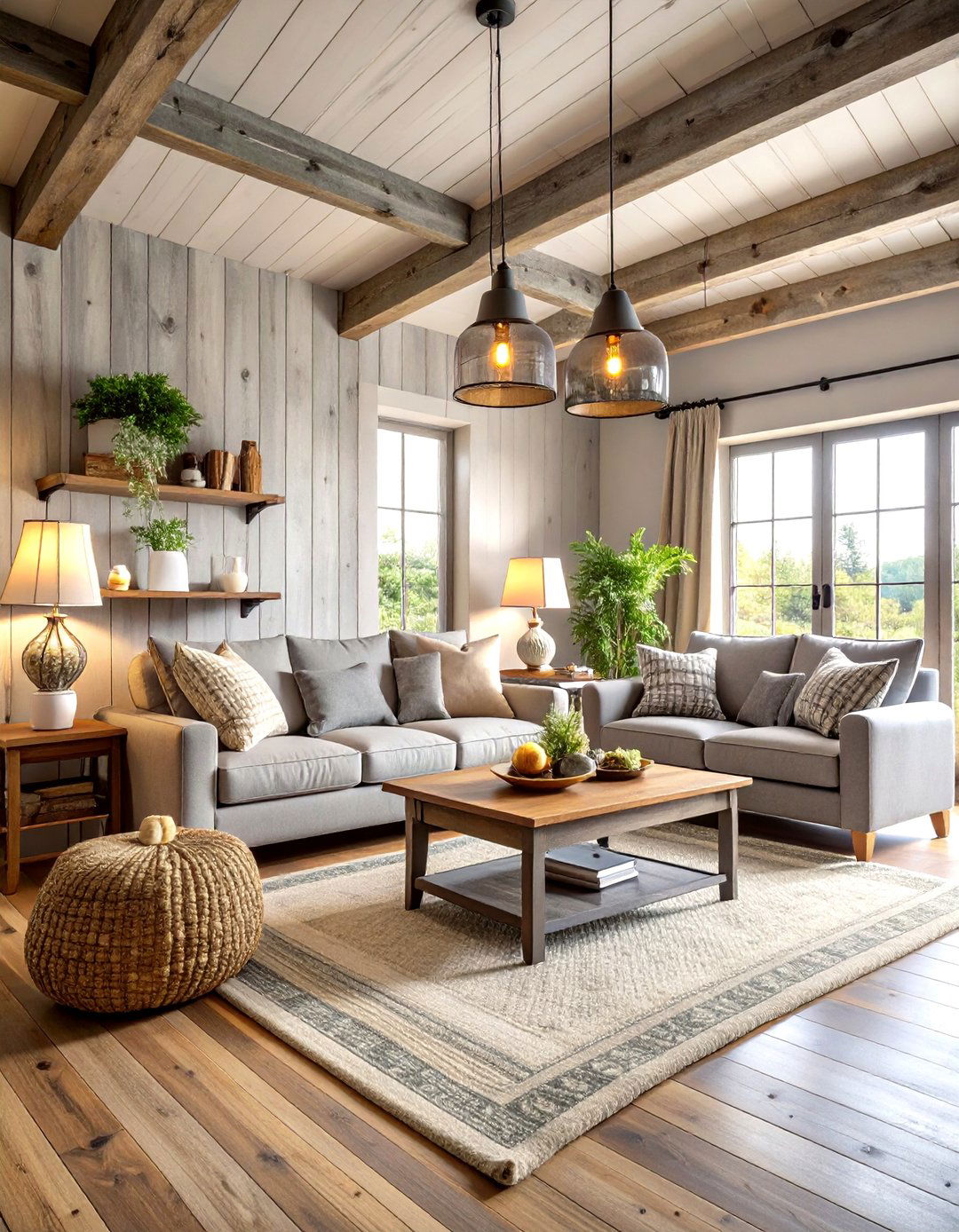


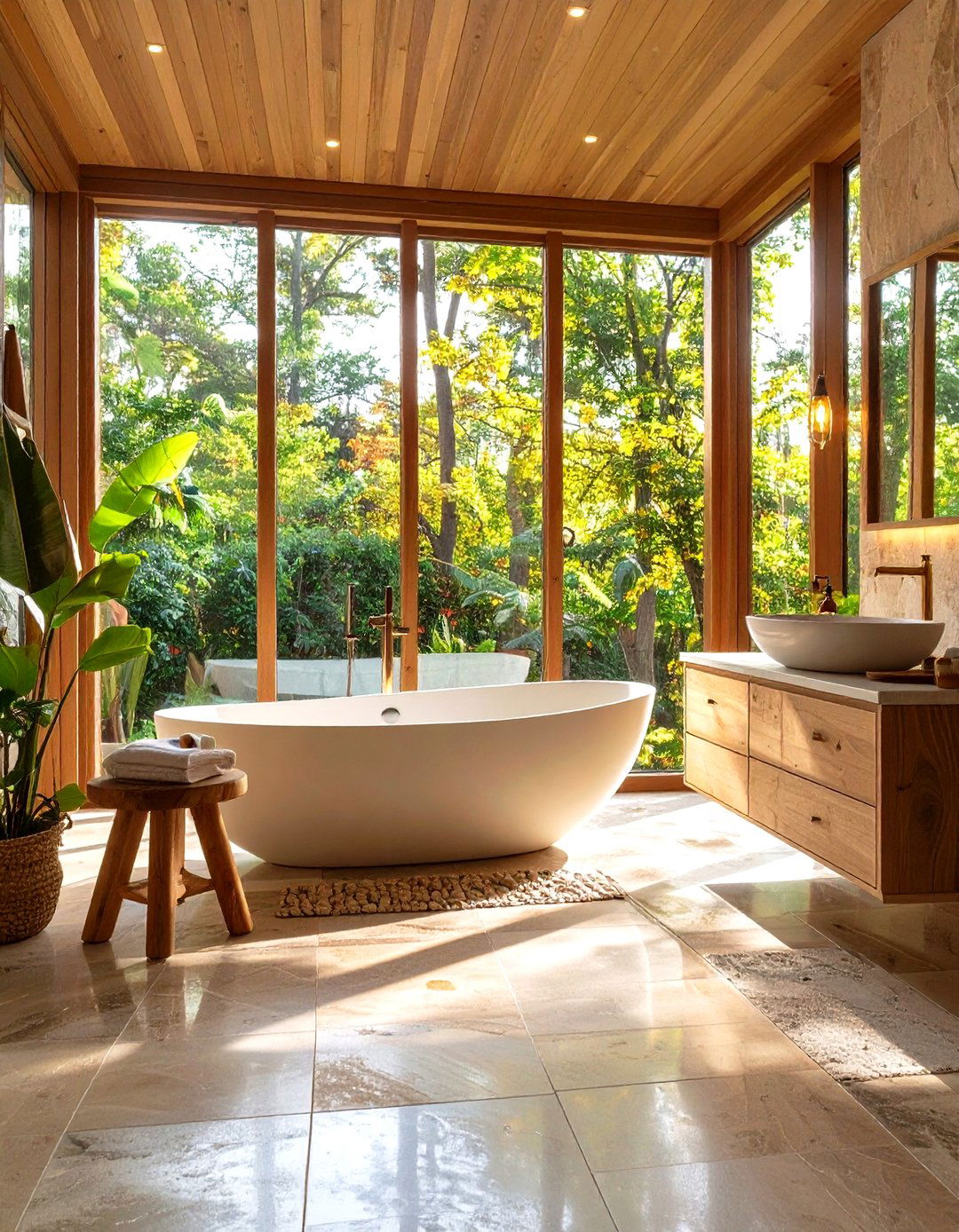

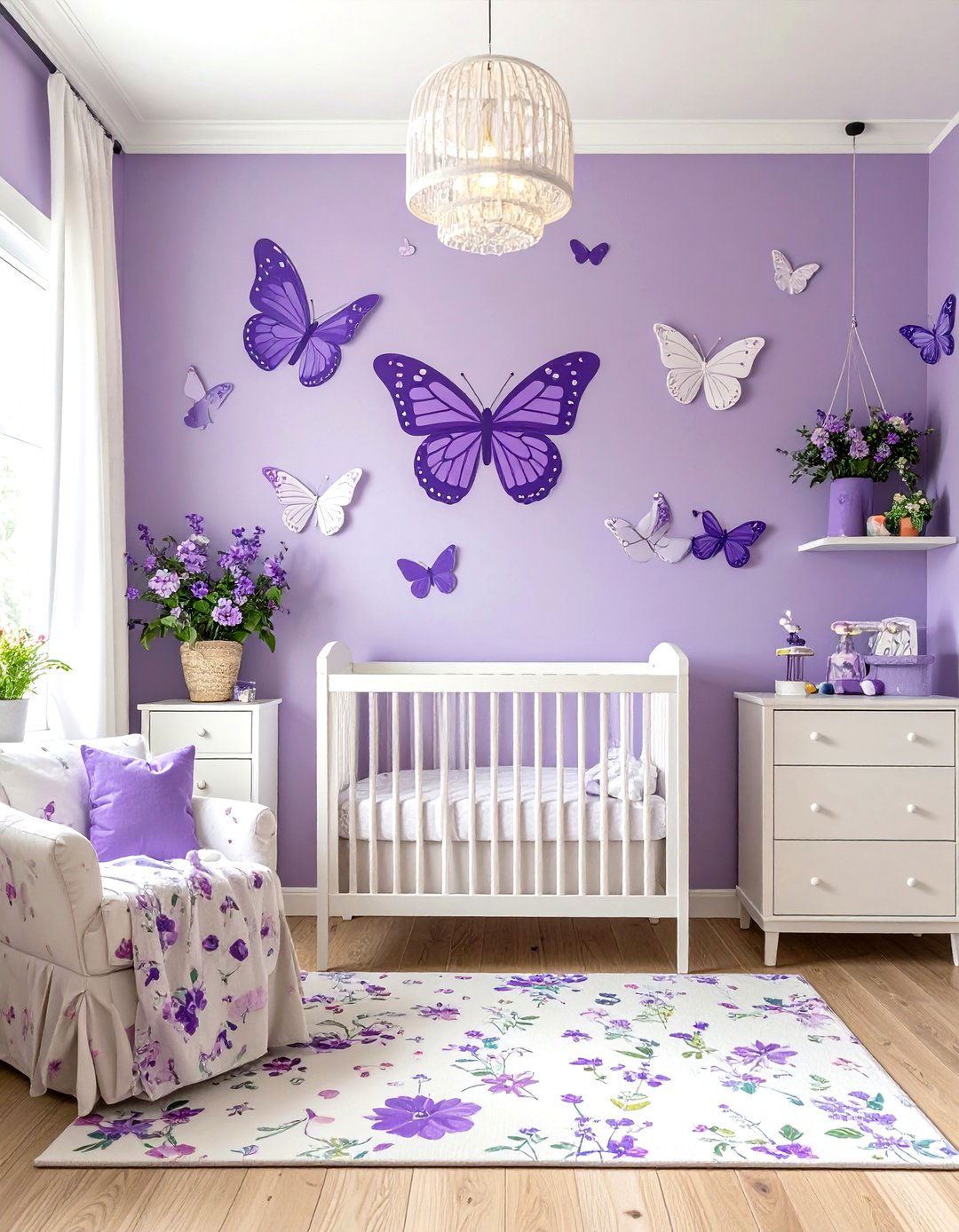
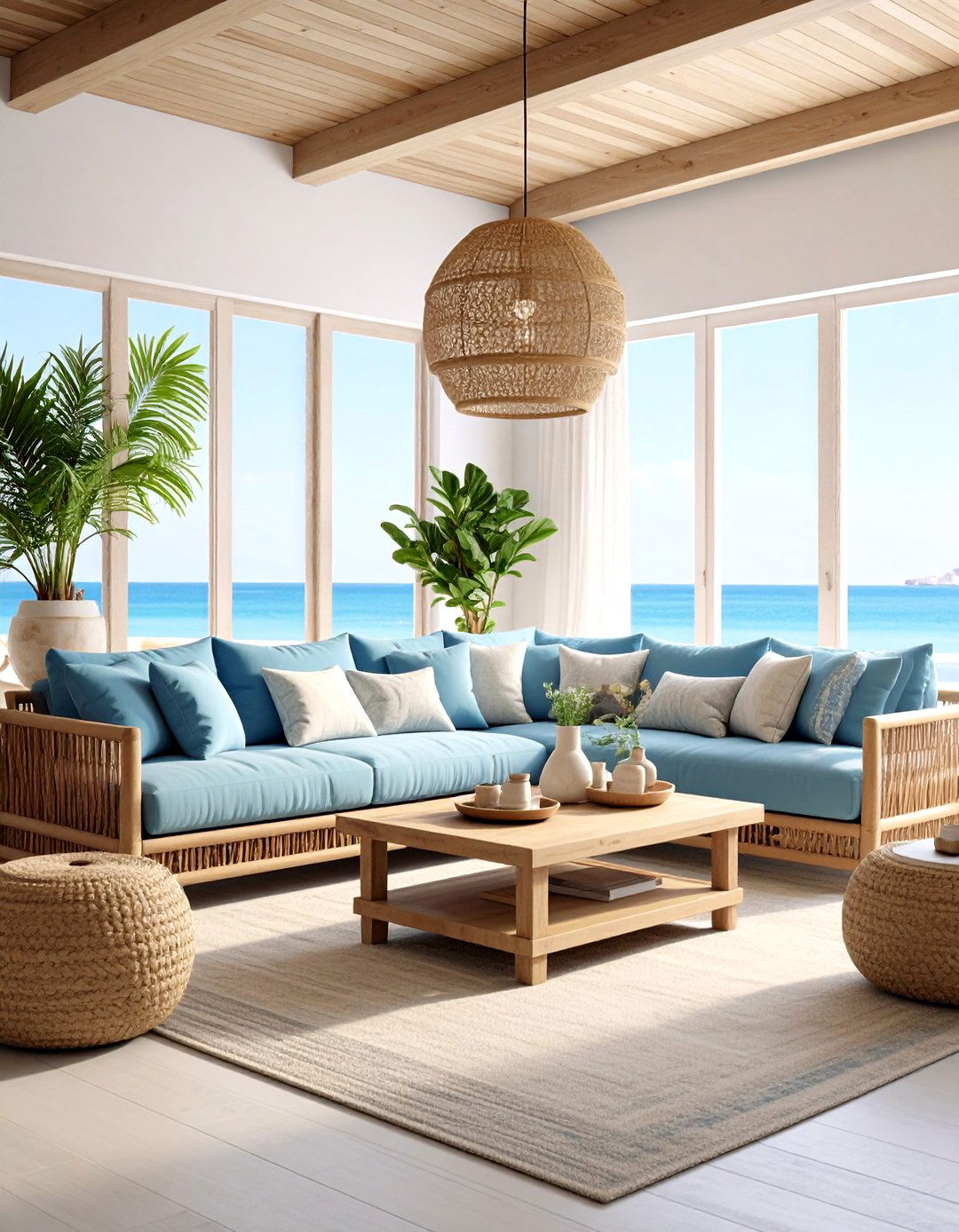
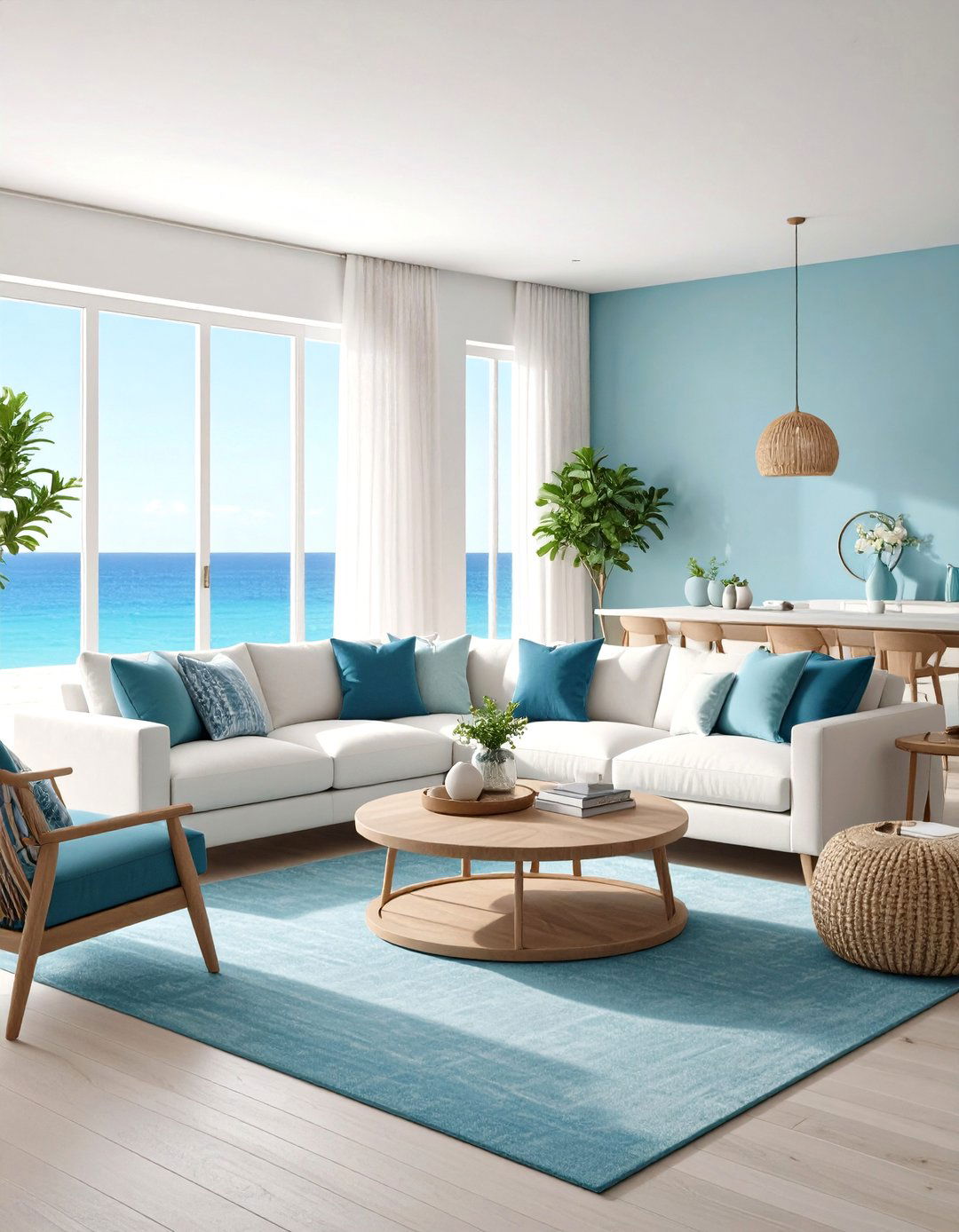
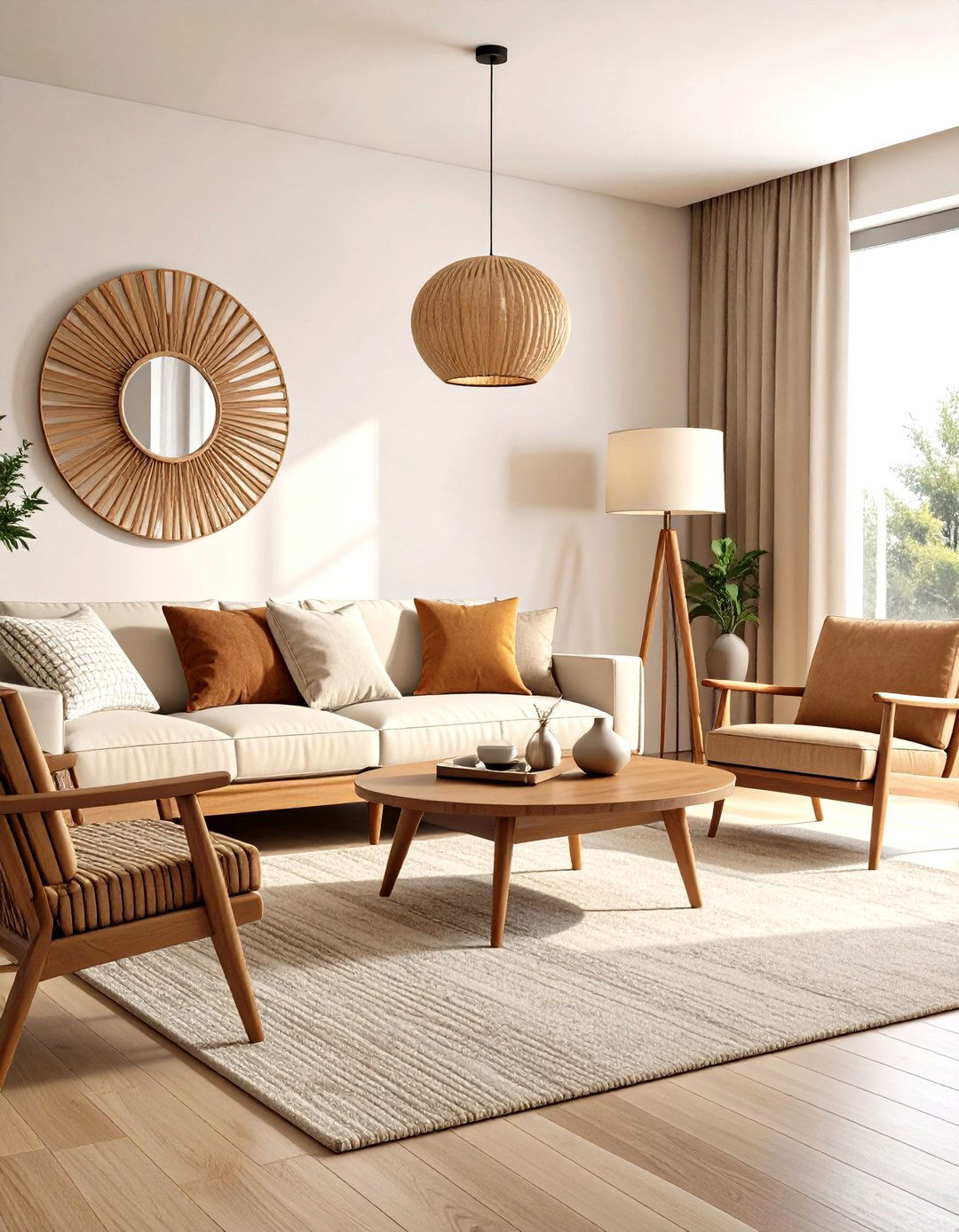
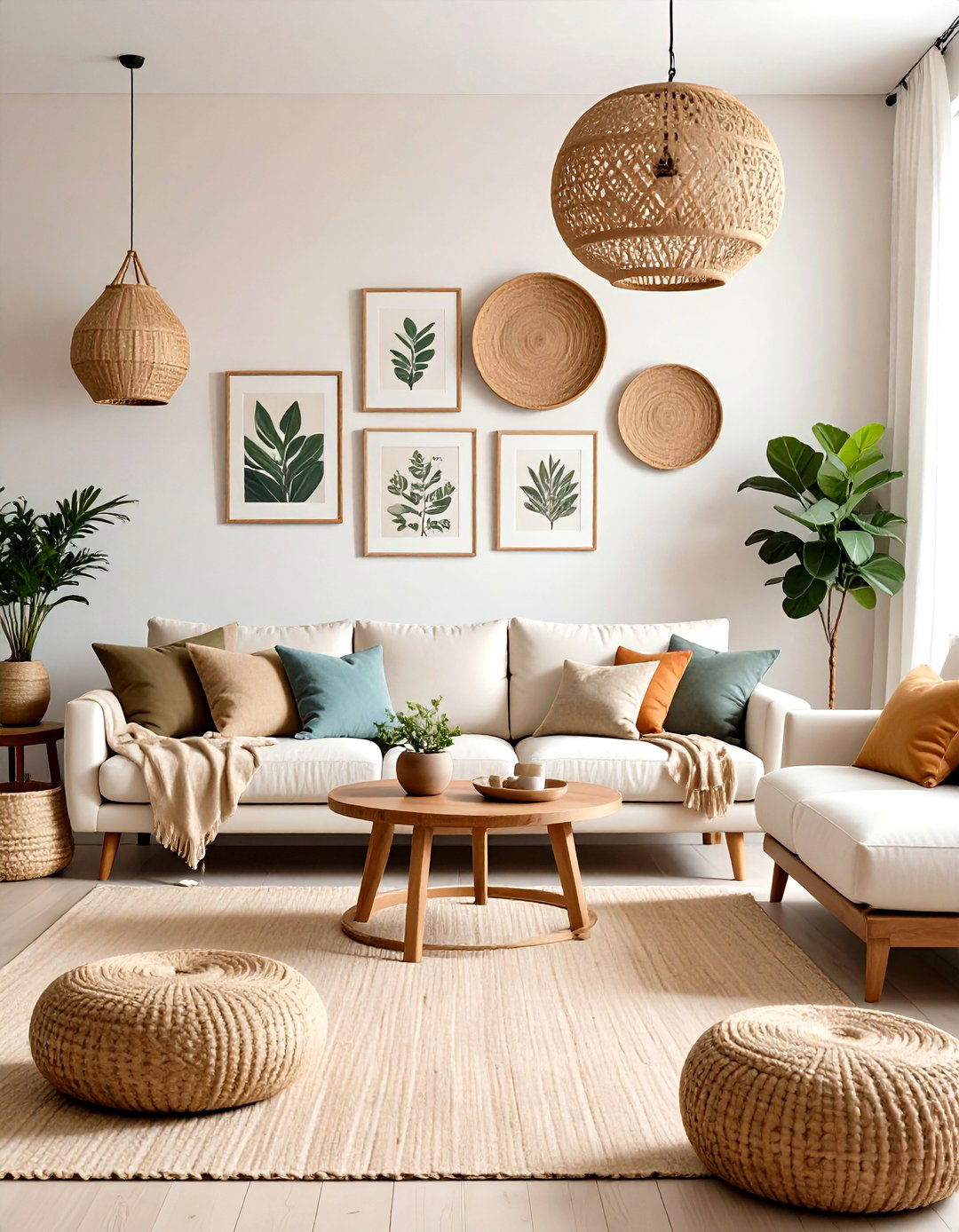

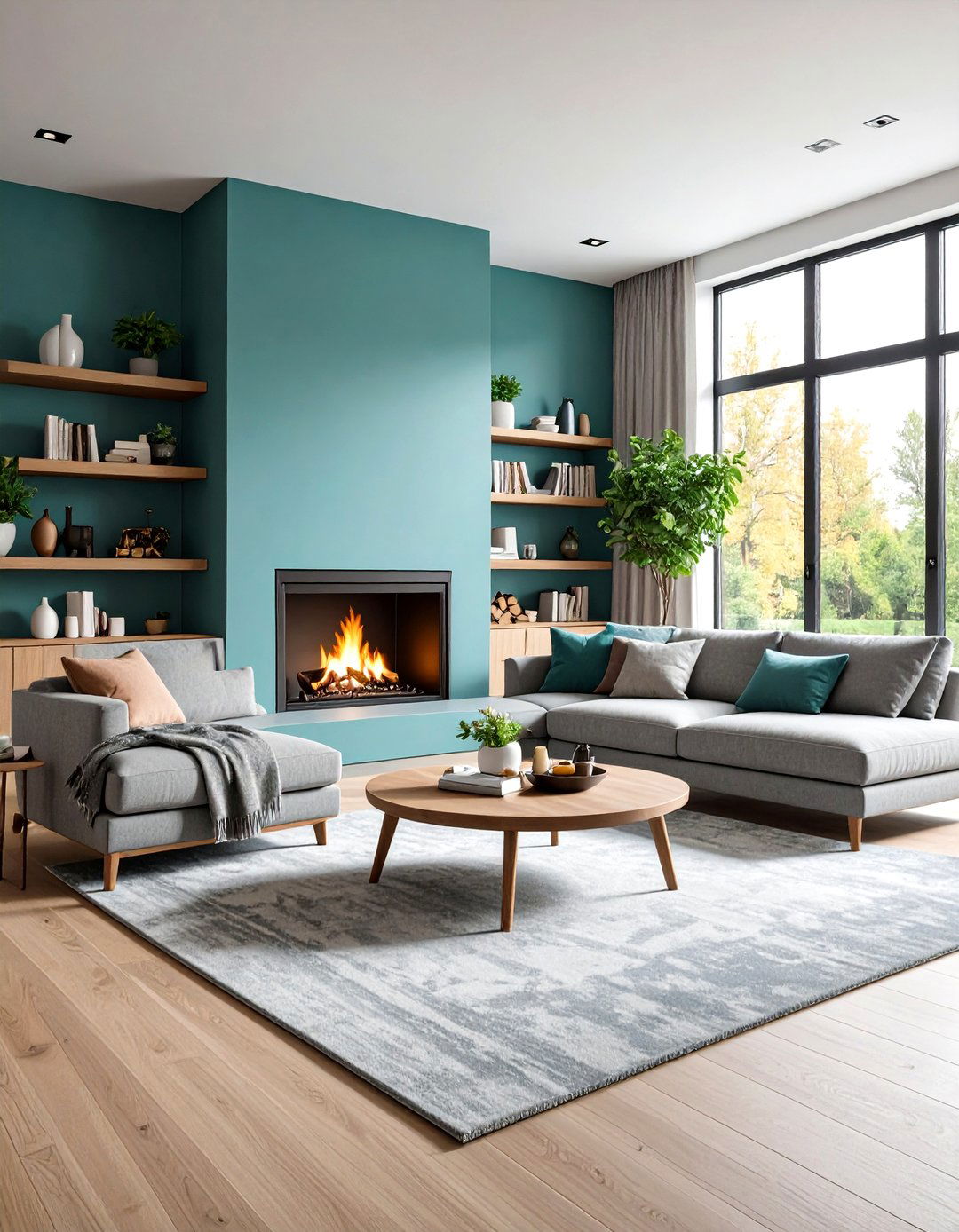
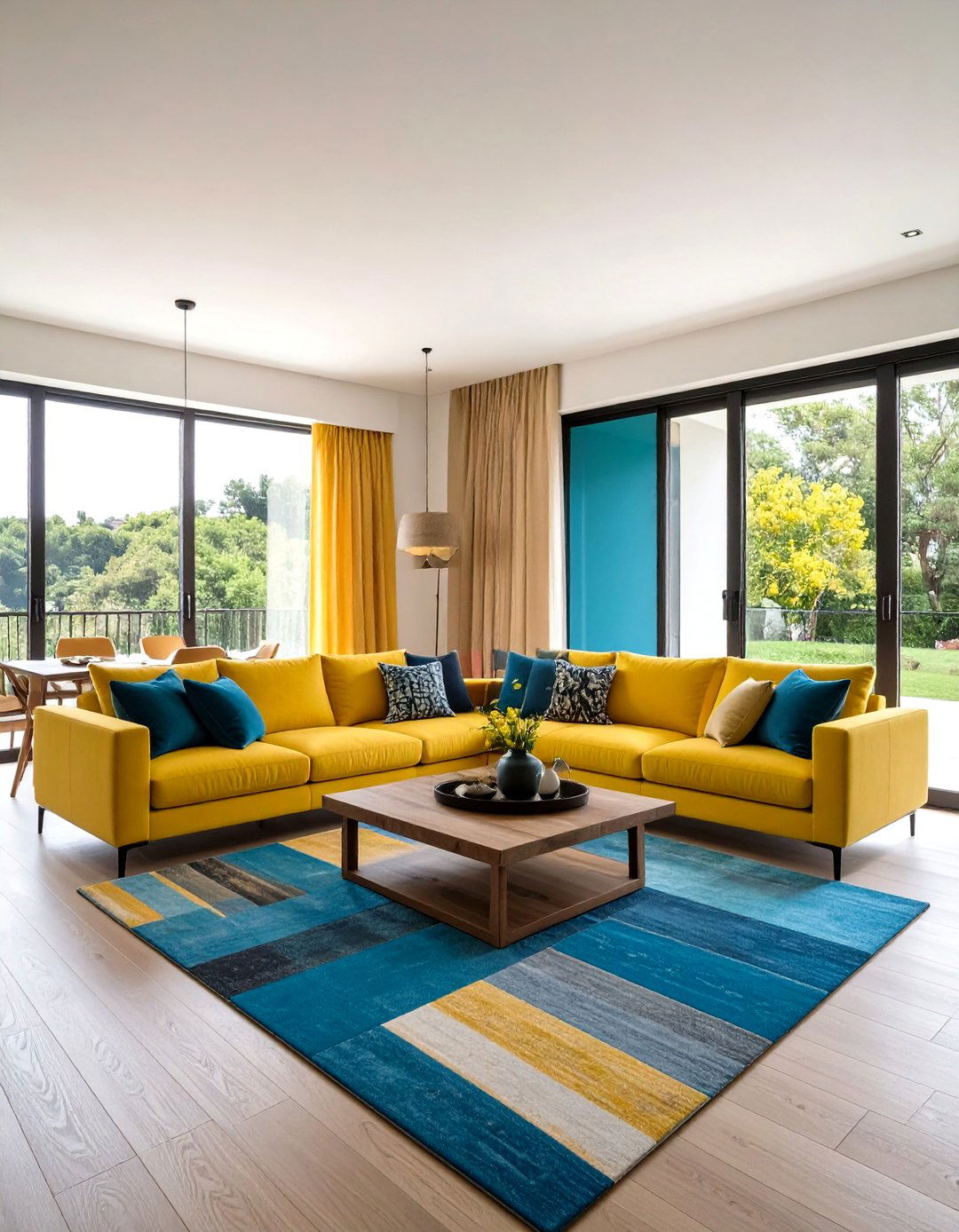
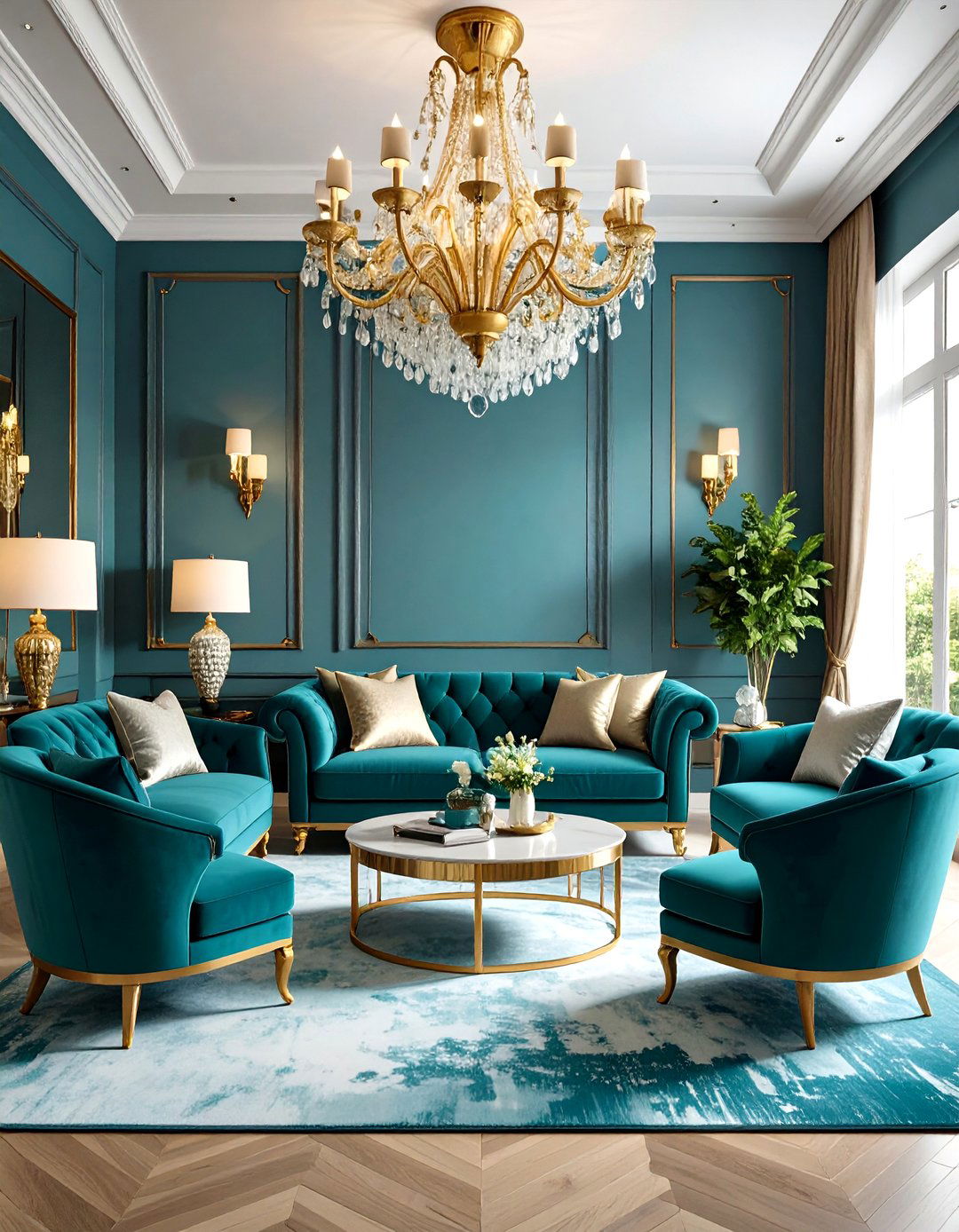
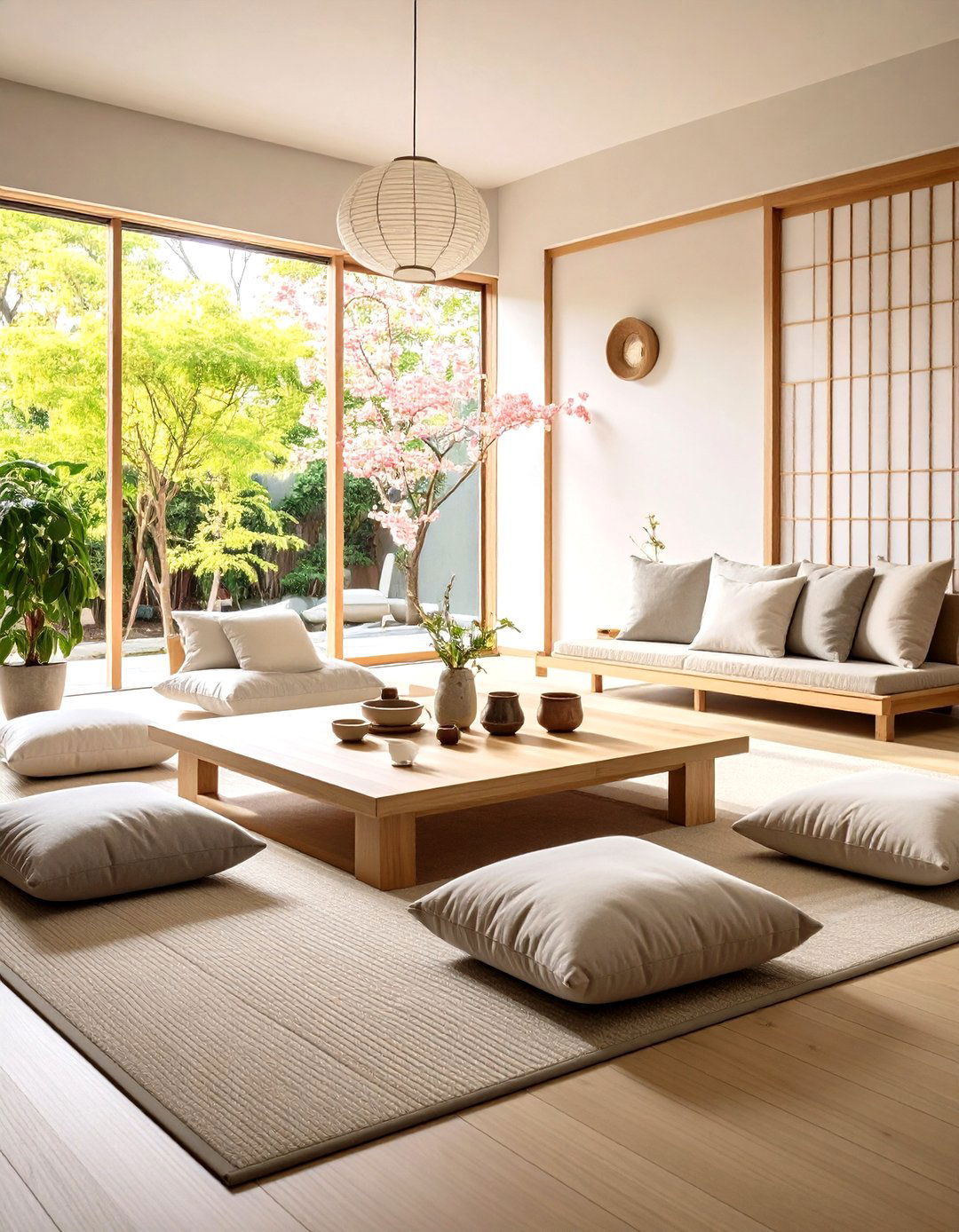
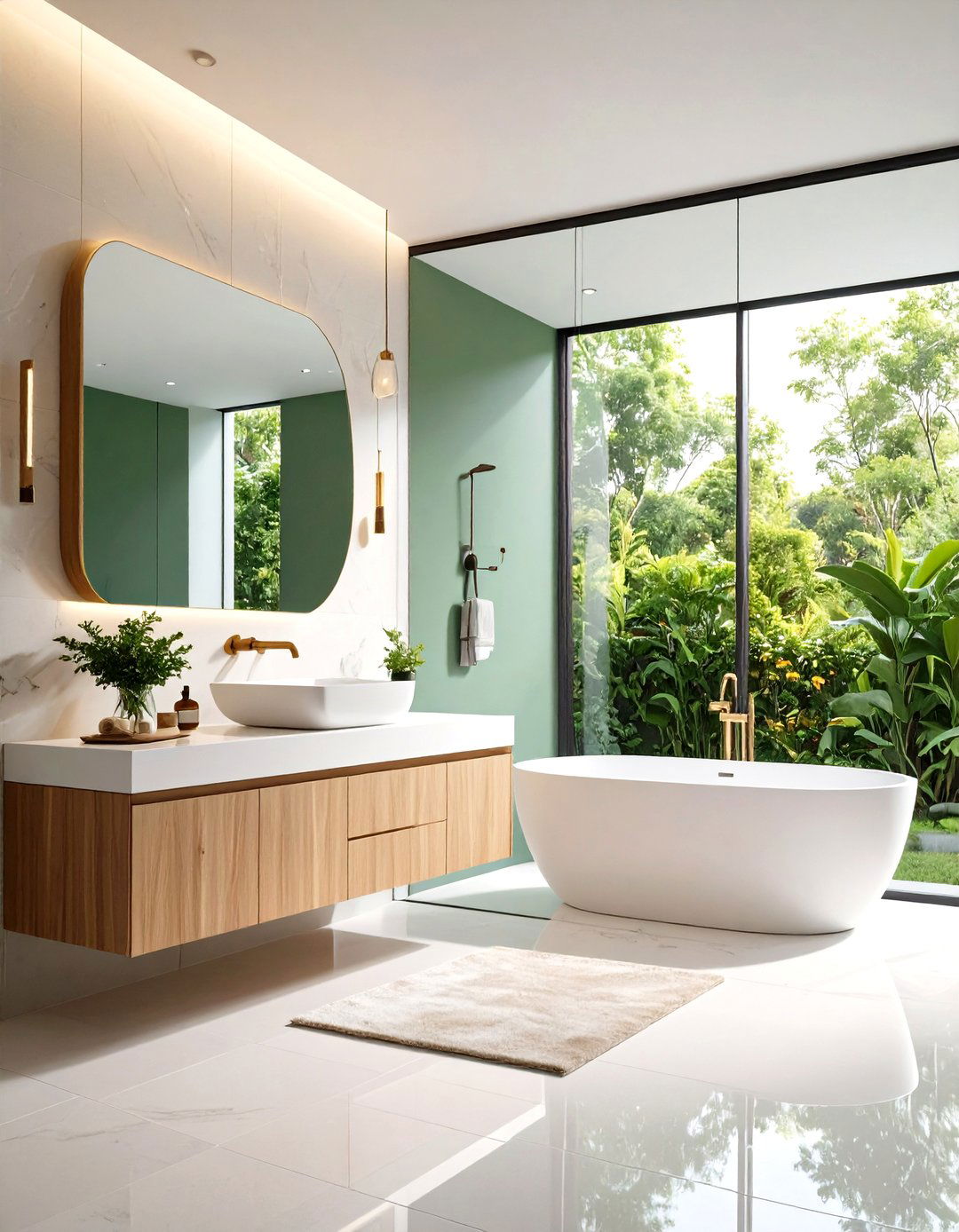
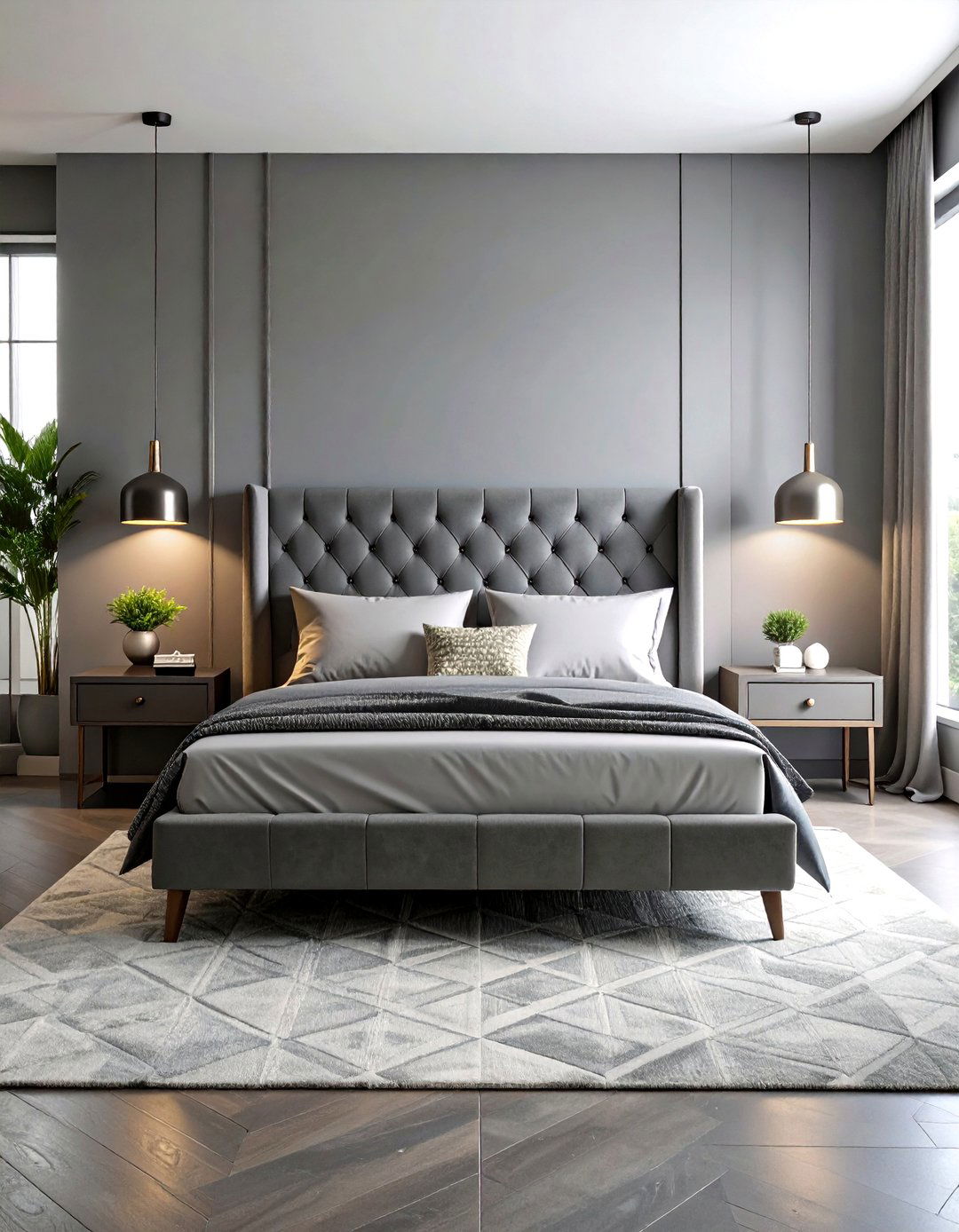
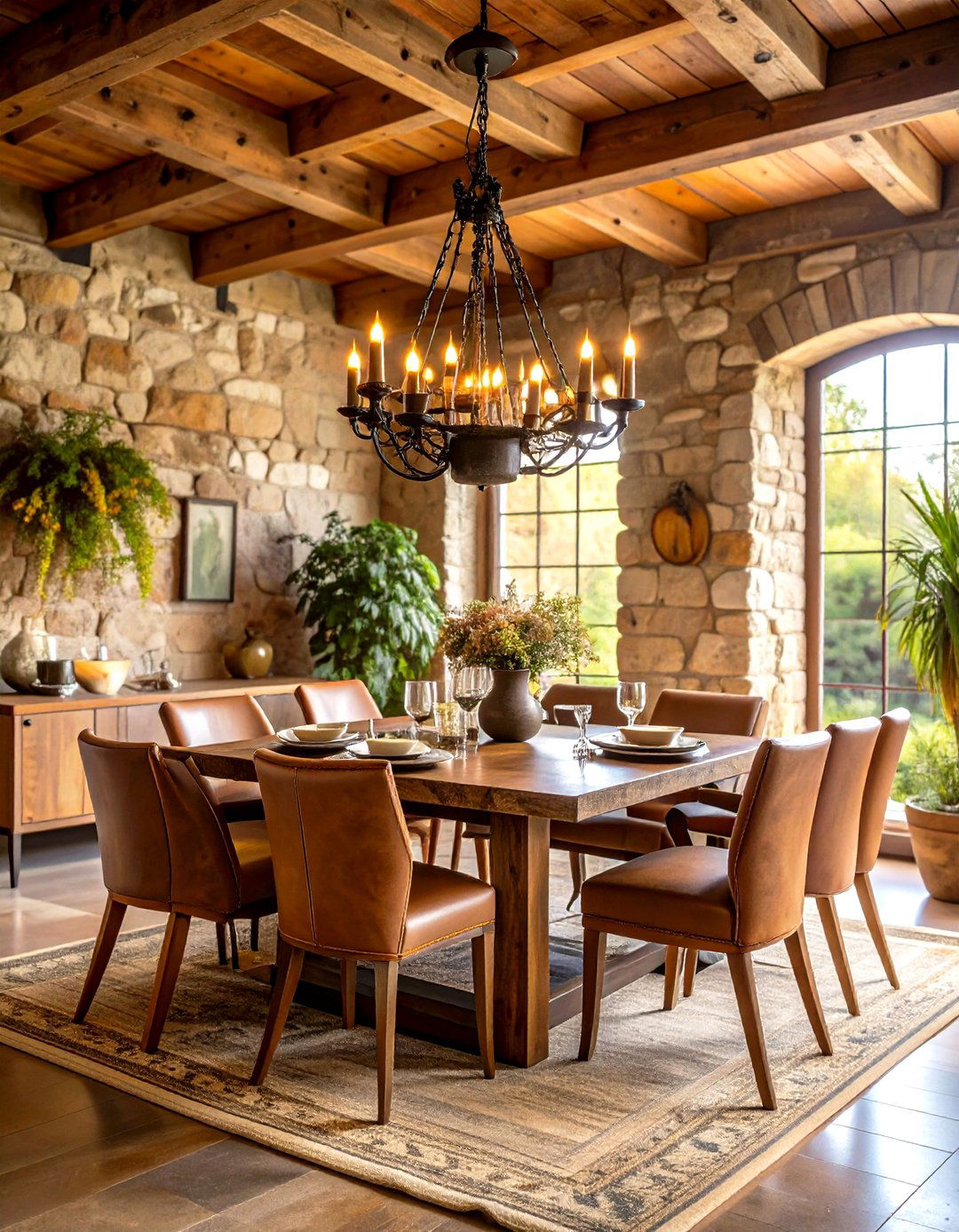
Leave a Reply